HOW ELECTRIC MOTORSPORT IS CHANGING THE WORLD


NEWS • REVIEWS • INTERVIEWS • ELECTRIC CARS • SOLAR • RENEWABLE ENERGY JULY 2023 FREE & + THE LATEST IN & FORMULA E
TRACK EXTREME E
BOTH ON AND OFF THE
Enjoy fast, rapid or ultra-rapid charging on 98% of our network.


Whether it’s local deliveries or long-range journeys, we’re here to keep your drivers and your business powered up for the road ahead.
Allstar One Electric. Got yours yet?
Allstar One Electric




MONTH/YEAR DATE one electric
EDITOR’S NOTE
EV come, EV grow
made fantastic progress over the last few years, with over three quarters of a million electric cars now on our roads, but there is still lots more that can be done. On page 27, you can see what some of the brightest minds from the EV world think is essential in order for the sector to continue is incredible growth.
Just like the electric vehicles on our roads, electric motorsport is also growing, too. First of all, we have three in-depth reports from the three Formula E races that took place in June. As the title of that article suggests, the campaign is beginning to heat up and you can read all about it on page 11.

Our motorsport content doesn’t stop there, however. Electric motorsport has become more and more popular over recent years and so I investigated that growth in popularity and look at how electric motorsport is having an impact both on and off the track. Head over to page 17 for this special feature. Elsewhere in this issue, you’ll find another e-bike review, as well as all the usual news, views and features that you expect from this magazine. We also have our ‘Electric Home’ section looking at the world of sustainable living with guides on how to cook efficiently to how to really harness solar energy. .
One of the many purposes of this magazine is to highlight and document the growth of the electric vehicle industry, not just in the UK, but across Europe and across the rest of the world, and this month, there is a particular theme of growth.
The subject of our ‘EV Powered Interview’ feature this month is Melanie Shufflebotham, the co-founder of EV charge point mapping service, ZapMap. In this feature, Melanie discusses the rise of electric vehicle charging in the UK and what is needed to accelerate the rollout of EV charging.
We continue to ask the question of ‘what does the electric vehicle industry need’ in our Top Ten feature this month. The UK’s electric vehicle industry has
Charlie Atkinson
Editor, EV Powered
The Turning Electric Team
Editor
Charlie Atkinson
Associate Editor

Cherry Martin
Graphic Designer
Grace Moseley
Videographer
Jacob Pinchbeck
Content Sales Manager





Laura Phillips
Capital Business Media, Group MD
Richard Alvin
Business Development Director
Stephen Banks
Chief Creative Director
Stuart Hyde
Finance Director
Andrew Martin
3 TURNING
MAGAZINE
ELECTRIC
As always, we have more news, features and opinions waiting for you inside. Enjoy the read!
Turning Electric is published in London by © EV Powered Ltd a Capital Business Media group brand. Turning Electric is printed using sustainable paper sources and vegetable ink, and is PEFC certified. Copies are recycled at the end of each month. Capital Business Media Ltd, Level 18, 40th Floor, London, E14 5NR. Tel: 020 7148 3861





Contents 5 8 Zap-Map: In Charge Meet Melanie Shufflebotham, co-founder of Zap-Map. 12 Formula E Three different winners across three races - the heat is on! 16 Extreme E All eyes on the Island X-Prix. 18 Electric Motorsport How electric motorsport is changing the world, on and off the track. 24 Specialized S-Works eBike Review A trail blazer in its class, by Richard Alvin. EV News The latest from the EV industry. 24 26 What’s New? A monthly round-up of all the latest releases and upcoming EVs! 16 18 28 Ten Things The EV Industry Needs! We find out what it needs to continue to grow. 34 Demand for EVs in UK Cities The UK cities with the most and least demand for EVs. 35 Getting Female Drivers On Board... ...the shift to electric. 38 Electric Home News The latest news and updates for everything Electric Home. 42 Tackling Energy Costs How businesses remain competitive whilst tackling energy costs. 43 What is it Cheaper to Cook With? An air fryer, oven, microwave or slow cooker? 44 Harnessing Solar Energy The ultimate UK guide. 46 Analysing Renewable Energy How does the UK compare with global trends. 49 Harnessing the Power of Summer Top tips for maximising renewable energy usage. 50 Investing in a Home Battery A green and economic power solution. 12 26 TURNING ELECTRIC MAGAZINE 4
ASTON MARTIN to create high performance electric vehicles
Aston Martin is pressing forward with its plans to create electric vehicles with a groundbreaking partnership with Lucid Group.
The proposed agreement would see Lucid, a world-leader in the design and manufacture of advanced electric powertrains and battery systems, supply Aston Martin with industry-leading electric vehicle technologies. Access to Lucid’s current and future powertrain and battery technology will be at the centre of Aston Martin’s all-new in-house Battery Electric Vehicle (BEV) platform.
Aston Martin’s electrification programme forms a pillar of the ultra-luxury brand’s wider Racing. Green. sustainability strategy and will see an investment of over £2 billion in advanced technologies over the next five years, with investment phasing from ICE to BEV technology.
An all-new bespoke platform, developed by Aston Martin, will form the basis of the Company’s entire future electrified model range; from hypercars to sports cars, GTs and SUVs, the first of which is targeted for launch in 2025. Before then Aston Martin will deliver its first plug-in hybrid – the mid-engined supercar, Valhalla – in 2024 and by 2026, all new Aston Martin model lines will feature an electrified powertrain option, with the

long-term objective for its core range to be fully electrified by 2030.
Mercedes-Benz AG will continue to provide Aston Martin access to a range of world-class technologies, including powertrain and electric/ electronic architectures for current and future generation Aston Martin vehicles, including internal combustion engine, hybrid and electric vehicles.
Lawrence Stroll, Executive Chairman of Aston Martin, said: “The supply agreement with Lucid is a game changer for the future EV-led growth of Aston Martin. Based on our strategy and requirements, we selected Lucid, gaining access to the industry’s highest performance and most innovative technologies for our future BEV products.”
5 EV NEWS
WELSH GOVERNMENT to invest £15m to increase EV charging
The Welsh Government
has
announced increased funding to boost electric vehicle charging infrastructure across the country.
£15 million in funding has been confirmed by Deputy Climate Change Minister Lee Waters to help local authorities across Wales to increase the number of charging facilities ahead of new fossil fuel vehicles being phased out in 2030.

The funding announcement follows £26m already invested in charging infrastructure across Wales since 2021, which enabled the installation of more than 1,600 charging points. In total, Wales currently has over 1,800 charging devices mapped on Zapmap, of which more than 360 are rapid charging points.
FORTESCUE to expand battery production with new UK facility
Fortescue is significantly expanding its battery and electric powertrain production operations in the UK with a new state-of-the-art facility in Oxfordshire.
Following entry-into-force of the Australia-UK Free Trade Agreement (FTA), Fortescue will open a new state-of-the-art site in Banbury, Oxfordshire, significantly expanding its UK manufacturing capability, supplying advanced batteries and electric powertrains globally.
The new location will be focused on production of a wide range of zeroemission products for the off-road sector including trucks and trains. It will form part of a new global business aimed at driving decarbonisation in all fields of economic activity, while building sovereign capabilities in emerging technology.
The factory will cover over 13,500m2 in total and employ over 120 highly skilled engineers, technicians, apprentices and graduates, with recruitment for the industrialisation programme starting now.

EV NEWS 6
NINE out of 10 local authorities have no strategy for EV infrastructure
A recent poll of council representatives has found that more than 9 out of 10 local authorities do not yet have an EV charging infrastructure strategy in place.
The poll, taken by Charge Point Operator (CPO) Believ, suggests that more than nine out of 10 (91%) local authorities do not yet have an EV charging infrastructure strategy in place, adding to growing concerns that the rollout is falling well behind the Government’s ambition to deliver 300,000 charge points by 2030.
Perran Moon, Interim CEO at Believ, says that recent findings are
NFU ENERGY partners with ZEST to boost rural EV charging
Landowners and farmers may soon be able to transform underused brownfield sites into EV charging hubs, destination EV charging and solar canopies, thanks to a new partnership between NFU Energy and Zest.
Under the terms of the partnership, NFU Energy will extend its business energy services to include Zest EV charging solutions. Giving advice and practical support to businesses, with a special focus on agriculture and horticulture, NFU Energy customers will benefit from Zest’s fully funded and fully managed EV charging infrastructure.
Zest is backed by the government-sponsored £420m Charging Infrastructure Investment Fund (CIIF), designed to accelerate the UK’s provision of public access charge points. It means that Zest can invest in comprehensive facilities and operate them over the long term. Recent projects include Metrocentre, Hackney Council and Transport for London.
reflective of the situation on the ground and a lack of urgency in the roll out of vital EV infrastructure: “Our findings suggest that there is still clearly a hesitancy due to lack of time and lack funding by local authorities to begin the process of rolling out charge point infrastructure. And crucially, local authority’s need the support, expertise, and guidance from charge point operators.”
NEWS IN BRIEF
The Kia EV6 GT has completed the 1000 Miglia Green 2023, finishing as the highestranking performance electric vehicle entered into the race and sixth overall.
Brits who drive electric vehicles have a greater appetite for ‘jaunts’ to Europe than those with petrol or diesel cars, a study from Start Rescue has found.
EV adoption is set to soar in the coming years, with over 100 million passenger EVs expected on the roads by 2026, according to new research from BloombergNEF’s (BNEF) latest annual Long-Term Electric Vehicle Outlook (EVO).
Electric car drivers are invited to explore some of the Lake District’s most iconic destinations by taking a road trip on the EV Trail - a 74-mile route featuring 50 kW rapid chargers which takes in highlights of the Lake District World Heritage Sites.
Owners of electric cars could soon face a ‘pothole tax’ for driving heavier vehicles, according to motor experts at LeaseElectricCar.co.uk.
7 EV NEWS
ZAP-MAP: IN CHARGE
Melanie Shufflebotham, co-founder of the UK’s leading EV chargepoint mapping service, Zap-Map, discusses the landscape of electric vehicle charging in the UK, the challenges it faces, and what the future of charging may look like.



What is the story behind Zap-Map?
Zap-Map started with me and my co-founder, Ben Lane. We had another website, nextgreencar.com, which was really all about finding a low emission car. From that we were looking at all sorts of different cars and in around 2012, we realised that electric cars were really going to be the winners. We thought, at that point, the electric car drivers out there, how are they going to be able to find charging points? So we started by adding around 700 public charge points at that point into a spreadsheet and popped it up in a Google map within our website. Over the next couple of years, it became the most popular page on the website. People started emailing us and saying we need an app and we thought “ohh we’re on to something here.” At the same time, the number of EV’s that were being sold in the market were going up as well. The market was growing, there were more and more people getting EV’s, so then we thought, we need to create a brand and set Zap-Map free.
ZAP-MAP 8 INTERVIEW AN
How have you seen the electric vehicle charging industry change since you founded Zap-Map?


There’s been an absolute massive change. I think at the beginning, the people who had these were real pioneers and then became early adopters. So they were very knowledgeable and happy to do a lot of research and think thinking about things before going on a journey. The majority of cars had much lower range so public charging was very, very important. There were also a lot less chargers. In some places there were no chargers at all. Ecotricity started rolling out their charge points along the motorway network, which was, I think, a very significant moment. Now, there are charge points across the whole country. We’ve got the whole range of charge points, from the very low powered charge points on streets all the way up to the high-powered 350-kilowatt charge points. The people have changed so now it’s moved on from the very early adopters to maybe the early mass market where people want to buy an electric car. They know all the advantages and want to get in and they want to just start to charge and start to use it. That means that everything needs to be a lot more simple. We need to have clearer language and everything needs to just work. I think those are probably the main the main changes.
What does the landscape of electric vehicle charging look like in the UK at the moment?
In 2023, we’ve seen that installations have really picked up pace. On average, over the last five months, we’ve had an average of around 1,600 new chargers installed and that’s compared to the same time last year, where around 900 a month were installed, so you can see that’s a big shift
up. Within that, the main thrust of the installations has been on ultra-rapid, 100 kilowatt or more chargers which is really great to see because that is the most visible area and the area where people can see the charge points and it makes a big difference to people. We’ve also seen a big increase in the number of charging hubs. I looked at the numbers and there’s now 140 charging hubs with more than more than six rapid or ultra-rapid chargers, and then an additional 60 or so from Tesla. That’s that’s a significant increase from last year.
9 ZAP-MAP INTERVIEW AN
UK too obsessed with targets for EV adoption and charging infrastructure?
I think the whole topic of targets is interesting. That target of having six rapid or ultra-rapid charge points at every single motorway services is clearly really important for the infrastructure. That is something that I would like to see happen. We know that there are some challenges in terms of installing these. The will is there and I think the money is there, but there are some issues with getting the right connections so that these charge points can be installed. I think the flip side of that is that some motorway service stations, there are many more than six already. In the areas of high demand, you’ve got some some charge locations which have got 12-24 chargers already installed. I think also you’re finding that the motorway service is just one place to charge, but the number I was saying before i.e 140 charging hubs, very, very few of those are on the motorway service areas. They might be just off on a road, they might be near a large town, so the charge point operators, if they’re not able to necessarily to install at the motorway service areas because of the contracts that are in place, they are finding locations just off the main routes and people are going to them.
Are there enough charging solutions for everyone? What do you say to the people with no offstreet charging options?

There’s at least three different types of charging. There’s on-route charging which is very high profile and what EV drivers want. They want reliable chargers. They want more than one charger in a location, so they could be confident of a charge. They want it to be as high speed as possible and they want it to be near the key journey route, and I feel quite confident that that’s being installed at a decent rate. Then right at the other end of the scale, home charging. When we survey our Zap-Map users, 84% of our users have home charging so they are happily charging at home and we think that those 600,000 home chargers can be a huge resource for community charging, sharing those charges with others, those people who don’t have off-street parking. In the middle, there are all these destination chargers, which actually is the biggest category and they are at car parks and attractions, at B&B’s, at hotels and out of the 40,000 devices that are on Zap-Map, at least 20,000 we would categorise as destination chargers. For me, these are more about having the opportunity to have a charger to top up wherever you go.
We’ve currently got just under 800,000 electric car drivers on the road now. There are 30 million drivers out there and by 2030, when the ban comes in, there’ll be 10 million electric cars on the road. Even by 2030, there will be 20 million cars out there, which will, overtime, go electric. Everyone will be going electric in the next seven years. Obviously, I’d love that to happen as quickly as possible, and it’s to me it’s a no brainer for people who’ve got off street parking for the reasons we know. For those people who don’t have off street parking. I think it is a little bit more of a decision. I would say firstly, is there charging available in your area? Either community charging
or local charging that is suitable for you? Or can you influence your local authority to start providing some charging? And what is your appetite to do that charging? I think it is less clear cut. If you haven’t got off street charging, there’s lots of solutions out there, but as an individual, you need to be up for it.

INTERVIEW AN
WHAT
FIND OUT PAGE
DOES INDUSTRY
WHAT ELSE THE EV INDUSTRY NEED? OUT ON PAGE 27
Scan this QR code to listen to the full interview with Melanie on The Everything EV Podcast

The HEATis
ON!FormulaEWorldChampionship
ROUND 10

Back in June, Formula E descended on the Indonesian capital of Jakarta, where the teams and drivers faced brutal conditions and a campaign that was turning onto the home straight.


Having led the way for the majority of the campaign, Porsche’s Pascal Werhlein responded to losing his place at the top of the Drivers’ Standings with his third win of the season.

The German had slipped down the table with a tenth placed finish last time out in Monaco, but Werhlein regained control of the season with a controlled drive in the Indonesian capital.
Porsche’s Wehrlein started third and traded places for the lead with polesitter Maximilian Guenther over the opening third of the E-Prix. From Lap 12 and the second Attack Mode activations, Wehrlein was able to manage things comfortably, despite temperatures reaching the mid-thirties.

Avalanche Andretti’s Jake Dennis started and ended the race in second place, his fourth consecutive podium and his sixth overall this season.
Polesitter Max Guenther secured a well-earned podium place with his third place finish, Maserati’s second podium in the manufacturer’s debut season.
Three different winners races in June saw the
The DS Penske pairing of Stoffel Vandoorne and Jean-Éric Vergne finished fourth and fifth respectively, ahead of Guenther’s teammate Edoardo Mortara who finished only his fifth race of the season.
Envision’s Nick Cassidy failed to build on his win from Monaco, with the Kiwi coming in seventh place ahead of Werhlein’s teammate Antonio Felix Da Costa. ABT Cupra’s Robin Frijns and McLaren’s Jake Hughes completed the top ten.
Jaguar’s Mitch Evans was the only driver not to finish following another collision with teammate Sam Bird, who finished second from last in 20th. With just three laps to go, Bird was utilizing his second Attack Mode when an error sent him into the back of Evan’s car. Evans was in eighth at the time, having started 11th, and the incident cost Jaguar some valuable points.
In a quote from the Jaguar team after Round 10, Bird said he took “full responsibility for the incident on track.”
“I want to apologise to the team for the mistake. We had a difficult qualifying and race, and unfortunately, so far this weekend, the car hasn’t been performing at the level we would hope. We’ll regroup tonight and come back stronger tomorrow.”
ROUND 11


Max Guenther made the most of his second consecutive pole position to claim Maserati MSG Racing’s first win in Formula E.


The German driver had nailed qualifying over the weekend in Jakarta but was unable to convert his starting position into a win on the Saturday. However, Guenther managed his Attack Mode’s expertly to claim his first victory of the season.
His closest rival on the day, Jake Dennis, made the move for his Attack Mode early but was unable to snatch the lead over Guenther with his extra power, and by the time Guenther made the move his second activation, he had built up a big enough lead to come out in front of the chasing Brit.
The strategy worked, and by the time Guenther crossed the line, he had 2.822 seconds on Dennis more than 18 seconds on third-placed man Mitch Evans.
Nobody had won by more than two seconds in the GEN3 era since Dennis’ season-opening victory in Mexico City and that margin was the biggest win in the last ten rounds. That marked Maserati’s first world championship single-seater win since Juan-Manuel Fangio’s legendary victory at the Nurburgring all the way back in 1957.
Finishing behind Guenther, Dennis and Evans was the unlikely pairing of the Nissan Formula E Team, with Sacha Fenestraz and Norman Nato coming in fourth and fifth. As the race reached its final few laps, the pair darted up the grid with Fenestraz’s move on reigning World Champion Stoffel Vandoorne one of the moves of the race.

Further down the grid, however, standings leader Nick Cassidy came into contact with his closest title rival Pascal Werhlein on lap 20, with the Kiwi coming off second best and shuffling down the pack into 19th and with significant damage.
With Werhlein securing a sixth placed finish, the German had regained the lead in the Drivers’ Standings with five races of the season left. Werhlein finished just ahead of his teammate Antonio Felix Da Costa, and Edoardo Mortara, Stoffel Vandoorne and Seb Buemi of Envision Racing rounded out the top ten.
winners across three battle for the Championshipheatup!
That marked Maserati’s first world championship single-seater win since Juan-Manuel Fangio’s legendary victory at the Nurburgring all the way back in 1957.
“”
ROUND 12


Envision Racing’s Nick Cassidy clambered from 10th to the top step of the podium in an enthralling inaugural Southwire Portland E-Prix Round 12.
Cassidy measured his race to perfection from P10 on the grid as the 22-strong field jostled for the top spot over the 32-lap encounter. Just seven seconds split the first 17 runners, while the race produced some 403 overtakes.
The strategic battle for top spot was evidenced from the opening lap at Formula E’s fourth US venue, as positions and race leaders changed corner by corner in groups five and six wide at points.

The Kiwi headed the way several times but finally got the better of da Costa, himself a race leader, on Lap 28 with the decisive move – only a few turns after the Portuguese had seized the initiative.
Cassidy first hit the front on Lap 3 while da Costa clambered through the pack from eighth at the outset to pile the pressure on the Envision Racing driver right to the flag but Cassidy held fast for a third win of 2022/23.
Polesitter Jake Dennis led the opening stages but wouldn’t time his late-race charge as precisely as Cassidy managed to.
The Avalanche Andretti driver would settle for second, though, as that proved to be enough for the Drivers’ World Championship lead as things stand – the Brit heading Cassidy by just a point and both taking full advantage with prior standings leader Pascal Werhlein (TAG Heuer Porsche) escaping contact to come home only ninth and in the points at the chequered flag. Third, meanwhile, was da Costa’s first podium in seven rounds – the last being that win in Cape Town.
On his 29th birthday, Mitch Evans (Jaguar TCS Racing) recovered from 20th on the grid to fourth – ensuring he’s still well in the fight for the title with four races to come in Season 9; two each at Rome next up on July 15 & 16 prior to the doubleheader finale in London.
FORMULA E 14



15
Jake Dennis Avalanche Andretti Formula E 154 PTS Nick Cassidy Envision Racing 153 PTS Pascal Werhelin TAG Heuer Porsche Formula E Team 138 PTS Mitch Evans Jaguar TCS Racing 122 PTS Jean-Éric Vergne DS Penske 97 PTS António Félix da Costa TAG Heuer Porsche Formula E Team 93 PTS Max Günther Maserati MSG Racing 78 PTS Sébastien Buemi Envision Racing 72 PTS Sam Bird Jaguar TCS Racing 62 PTS Jake Hughes NEOM McLaren Formula E Team 46 PTS 1 2 3 4 5 6 7 8 9 10 DRIVERS’ STANDINGS
FORMULA E
ALL EYES ON THE ISLAND X-PR
EXTREME E IS GEARING UP FOR THE DOUBLE-HEADER ISLAND X-PRIX WEEKEND IN SARDINIA!

The Island X Prix (8-9 July), co-organised and coordinated by the Automobile Club d’Italia and Regione Sardegna, will mark the championship’s return to the Italian island for a third successive year.
The electric off-road racing series will be returning to the familiar setting of the Italian Army Training area at Capo Teulada in Sulcis-Iglesiente. The Teulada route provides a challenging backdrop for the course, with some changes to this year’s configuration netting out at a track distance of around three kilometres.


Due to the hot summer conditions in July, the drivers will navigate a tougher, more compact surface compared to the Season 3 race locations so far. Riddled with rocks, bushes, and dry riverbeds cracked from the heat, the Sardinia course promises exciting wheel-to-wheel action across the two days of racing.
Alejandro Agag, Founder and CEO of Extreme E, said: “It is great to be returning to Sardinia for Rounds 5 and 6 of Season 3.
“Sardinia has proved to be a popular venue with drivers and teams in the past and has provided fantastic racing in our previous two events there. We are expecting more of the same in July, and with such a competitive grid in 2023 as the championship hots up, we look forward to a really special event.
“Our Legacy initiatives remain ongoing, while we hope to announce some new projects prior to this Island X Prix, and we are excited to see how they have developed alongside our supporting partners.”
RIX
DOUBLE-HEADER SARDINIA!

WITH SUCH A COMPETITIVE GRID IN 2023 AS THE CHAMPIONSHIP HOTS UP
Nico Rosberg’s Rosberg X Racing (RXR) are the most successful team when it comes to the Island X Prix, with two victories from three races on the Italian island since the series launched in 2021.
Sardinia has also proven to be a special event for No.99 GMC Hummer EV Chip Ganassi Racing, with the American outfit picking up their maiden championship win there last year.

Veloce Racing currently leads the Extreme E Season 3 standings after two victories in 2023., ACCIONA | SAINZ XE Team are a close second with 69 points – 11 off the lead –while Season 1 Champions RXR sit third. Last year’s winners, Lewis Hamilton’s X44 Vida Carbon Racing, are fourth in the standings.
With three different winners across just four rounds, the double-header format means more points up for grabs and more opportunities awaiting the 10 world-class teams in Rounds 5 and 6 of Season 3 in Sardinia.

THE COUNTDOWN IS ON!

17 EXTREME E
” “
WE LOOK FORWARD TO A REALLY SPECIAL EVENT.
How electric motorsport is changing the world

ELECTRIC MOTORSPORT 18
Charlie
Atkinson,
Editor of EV Powered, looks at the impact of electric motorsport,
In the grand scheme of things, electric motorsport is a relatively new concept. Whilst there are examples of electric-powered racing dating back to 1912, the first truly popular and successful electric racing series was Formula E, which was conceived in 2012 with the inaugural championship kicking off in Beijing in September 2014.
In that sense, top level electric motorsport is less than a decade old, and yet its growth has been remarkable. Today, we have some of the biggest names in all of motorsport competing in fullyelectric vehicles, and the number of fans and viewers are growing year after year.

The rise of electric motorsport over the past nine years has been tremendous, but the impact it is having is most impressive.
Numbers don’t lie
Electric motorsport has had to fight the same battle as regular EVs. Just as regular battery electric vehicles have had to compete alongside ICE vehicles, electric motorsport has had to coexist with the juggernaut that is Formula One.
F1 is one of the most popular sports in the world, and its legacy is deeply ingrained into the ‘oldschool petrolhead’ mentality that has looked to beat down the electric movement.
Continue onto next page
both on and off the track.
” “
F1 is one of the most popular sports in the world, and its legacy is deeply ingrained into the ‘old-school petrolhead’ mentality that has looked to beat down the electric movement.
This may be a bit of a sweeping statement, but I have experienced this first hand. When I first joined EV Powered, one of my first jobs was to report on the Formula E race in Rome back in April 2021. I had just started and wasn’t able to make it out to the Eternal City for the race, and so I watched it at home with my Dad and Grandad, both car-lovers, and both massive F1 fans.
The race hadn’t even started, but the comments had. “Don’t the cars sound weird?” “Aren’t they going to run out of power after five minutes?”
The conversation continued, but as the race went on, there were fewer and fewer comments. The race was full of action, with bumps and crashes, thrilling overtakes, and a racing format that was completely refreshing to the sometimesmonotonous Formula One events.
In the space of one Formula E race, two generations of F1 fans had become completely open to the idea of electric motorsport. And the numbers reflect that.
Last year, Formula E saw its cumulative audience increase 20% year-on-year to 381m as live viewership grew to an all-time high of
216m, up 10% on Season 7. Total viewing hours increased year-on-year by 58%, and the race in Jakarta was the most-watched domestic race in the championship’s 100-race history with a cumulative audience of 27.6m in Indonesia.
It’s a similar story for Extreme E, too, the fullyelectric off-road racing series. Only in its third season, the championship delivered huge growth in its global audience figures in 2022, soaring to 135 million viewers. This marks an improvement of more than 30% compared to its inaugural season in 2021.
These are just two examples, but it proves that there is a demand for electric motorsport, and these numbers will continue to grow as the competitions become more established and reach wider audiences.
Sport for purpose
Whilst the number of people watching Formula E and Extreme E races are great, there is a bigger picture to all of this. One of the biggest goals for electric motorsport is to help tackle the climate crisis and to raise awareness of these issues, whilst also promoting the benefits of electric vehicles.

ELECTRIC MOTORSPORT 20
ELECTRIC MOTORSPORT
most recent sustainability report: “Holding the event in Uruguay allowed us to capitalise on the country’s strong investment in renewable energy generation, with 98% of the country’s electricity being generated from renewable sources. Drawing on this low-carbon energy source and supplementing any additional onsite power requirements with onsite solar generation and hydrogen fuel cells allowed us to operate off 100% renewable energy for the Championship finale.”
life and end of life for all tyres, broken parts and battery cells. It is the first formula car to use linen and recycled carbon fibre in bodywork construction with all waste carbon fibre reused for new applications. Natural rubber and recycled fibres make up 26% of new Gen3 tyres which are fully recycled after racing.
Formula E has done a good job with this, but Extreme E has defined itself as the sport for purpose with its tagline ‘Race for the Planet’. Extreme E describes itself as “the first sport built out of concern for the climate crisis.” The series’ goal is to use electric racing to highlight remote environments under threat of climate change issues, and to encourage us all to take positive action to protect our planet’s future.
The series achieved a net-zero carbon footprint by the end of its first season, with the St Helena, a repurposed cargo liner which transports all the XE vehicles all around the world, a symbolic vessel of the motorsport and what it represents.
Last season, Extreme E delivered the first major motorsports event fully powered by renewable energy. As detailed in Extreme E’s

Formula E has also made great strides in terms of its environmental and sustainability goals. Earlier this year, FE was ranked as the World’s Most Sustainable Motorsport Championship by Enovation Consulting’s Sustainable Championships Index.
The Index ranked 105 series worldwide based on sustainability performance and awarded Formula E the top prize, largely due to the launch of the Gen3 car which is powered by electric motors that are substantially more efficient than internal combustion engines (ICEs) converting more than 95% of the electrical energy compared to approx. 40% in the high efficiency ICEs of other motorsports. In addition, the Gen3 has been likened to a ‘power station on wheels’ producing more than 40% of the energy it consumes in a race through regenerative braking.
The Gen3 is the first formula car aligned to life cycle thinking, with a clear path towards second
The Gen3 car is also helping drive a shift towards electric vehicles for all. As one example, the Nissan Formula E Team has used its electric motorsport division to showcase its EV prowess, with its FE exploits acting as a catalyst to further the brand’s electrification strategy.
“Formula E represents the pinnacle of EV technology, and we are confident this upcoming, next-generation series will deliver innovation and excitement on and off the track,” said Guillaume Cartier, Chairperson, Nissan AMIEO (Africa, Middle East, India, Europe and Oceania).
“With more than half of the races taking place within our diverse AMIEO region, our ability to implement road-to-track and tack-to-road knowledge exchange will directly contribute to the development of our electrified technologies and electric powertrains to deliver the best for our customers.”
Not only is electric motorsport tackling the climate crisis on the track, but it is helping to impact the everyday consumer by highlighting the benefits of electric vehicles and accelerating the shift to EVs.
21
“
Not only is electric motorsport tackling the climate crisis on the track, but it is helping to impact the everyday consumer by highlighting the benefits of electric vehicles and accelerating the shift to EVs.
”
Opportunities for all

Extreme E has been a pioneering racing series for its sustainability credentials, but also for putting women front and centre of one of fastest growing motorsport competitions in the world.

Unlike any other motorsport series, Extreme E teams are composed of a male and a female driver, with the drivers swapping at the halfway point of every race. The purpose of this is to eradicate
existing preconceptions around gender divides in motorsport, as well as removing barriers for female drivers competing at the highest level.
Catie Munnings has been competing in Extreme E since its inaugural season. Having racing at the European Rally Championship and the World Rally Championship, Munnings signed for the Andretti United Extreme E team (now known as Andretti Altawkilat) in 2021. Since then, Munnings has raced at some of the most remote locations on the planet on some of the most challenging terrains, picking up one win in her very first year.

Speaking about the role of women in Extreme E on The Everything EV Podcast, Munnings said: “I think it’s really positive. I’m always one for comparing yourself to the fastest driver, whether that be a boy or a girl, that’s the way that I grew up.
“Extreme E creates seats for girls which is fantastic because the fact that we’re on BBC and ITV and Sky Sports quite frequently, it’s mainstream and I think that’s the most important thing; they can be sat at home on a Sunday afternoon, turn the TV on and see a female driver against the guys. I’ve been to schools before with the Women in
Motorsport commission and we would ask the girls ‘who wants to be a Formula One driver’ and the amount of girls that would say ‘I didn’t know you could be because I thought that was just a man’s sport’ highlighted how much talent we were losing out on.”
But it is not just a tick-box exercise from Extreme E to have women at centre stage. Instead, it is about showcasing the talent of female drivers and giving them the platform to inspire the next generation, as Munnings pointed out.
“It’s also about making sure that you have females that are serious about it and that they are there
ELECTRIC MOTORSPORT 22
Catie Munnings
ELECTRIC MOTORSPORT
for the right reasons,” she said. “That was really important for me. We’ve seen teams enter girls for PR and media reasons and they often don’t get the same opportunities as the guys – They’ll be out the front doing the media interviews and the guys will be developing the cars out the back and that stuff really does have an impact. Experience is kilometres in this game and it’s expensive to test; we can’t just pick up a tennis racket and practice, so for me that equality is really important.”
The role of women in motorsport is growing outside of Extreme E, too, as highlighted by the FIA Girls on Track initiative.
Formula E has been delivering on that initiative alongside the FIA, and the series is dedicated to raising not only the profile of female roles within motorsport, but their diversity and routes of entry. So far, the programme has hosted nearly 2,000 girls at track, with further Season 9 activations at Formula E races in Sao Paulo and Jakarta.
It has a proven route of entry into Formula E, with several women in the championship having participated in the immersive one-day experience and developed a career in the electric series.

The new wave
So far, this feature has focused on the role of Formula E and Extreme E, but there is a wide range of up-and-coming electric motorsports which are looking to follow in the footsteps of FE and XE.
The World e-Bike Series is the first world series reserved to e-bikes only and has become one of the biggest biking events on the calendar. The newly launched E1 series is the first electric raceboat championship sanctioned by the Union Internationale Motonautique (UIM), the world governing body of powerboating. The eSkootr Championship also represents another side of e-mobility, with riders competing at speeds of over 100km/h on electric scooters.

Formula E and Extreme E have paved the way for a number of new and exciting competitions, all of which aim to have a positive impact on the environment whilst simultaneously highlighting the benefits of electric powertrains.
For most, electric motorsport, and motorsport in general, is a form of entertainment, where you can turn up (or tune in) and watch great racing spectacles. It can be, and already is, so much more than that, however. As Formula E and Extreme E have already proven, electric motorsport can be a catalyst for change, both on and off the track.
23
” “
As Formula E and Extreme E have already proven, electric motorsport can be a catalyst for change, both on and off the track.
SPECIALIZED S-WORKS TURBO LEVO SL II A TRAIL
The highly anticipated Specialized S-Works Turbo Levo SL II eBike is a trail-focused electric received a significant update, making it even more appealing to those looking for a versatile
DESIGN AND FRAME A Lightweight Carbon Masterpiece
The Turbo Levo SL II’s carbon frame is constructed using Specialized’s Fact 11M carbon. The company employed machine learning and Finite Element Analysis (FEA) to influence the frame’s shape, material usage, and overall design. This attention to detail has resulted in a lightweight yet sturdy frame that caters to riders of all sizes.

One of the most notable changes in the frame design is the absence of the sidearm strut, which has been synonymous with Specialized’s trail bikes. This bold move was made to save weight as the frames have grown larger, but the stiffness remains similar to the previous models. The internal cable routing and extensive chain-slap protection features on the chainstay make for a clean and neat appearance.
SUSPENSION Smooth and Responsive
The Turbo Levo SL II boasts 150mm of rear-wheel travel, achieved through Specialized’s Horst-link FSR suspension system. The redesigned leverage rate works to improve small-bump efficiency and mid-stroke sensitivity. This results in a more comfortable and responsive ride, especially when tackling rough terrain.
The rear shock has been custom-tuned to match the leverage rate, with compression damping that aids in bottom-out resistance while maintaining suppleness for smaller hits. Specialized has also reduced the rebound damping, allowing for quicker shock recovery.
MOTOR AND BATTERY More Power, Same Size
With its new Turbo SL 1.2 motor, the Turbo Levo SL II offers an increase in power from its predecessor, boasting 320W and 50Nm of torque. Despite the bump in power, the 320Wh battery capacity remains unchanged. However, the new bike is compatible with a 160Wh range extender, providing additional assistance when needed.
The MasterMind TCU display on the Turbo Levo SL II is customizable via the Mission Control smartphone app. With three standard riding modes (Eco, Trail, Turbo) and the MicroTune feature – which allows for adjustments in 10% increments – you’ll have complete control over your assistance levels.
GEOMETRY Adaptable and Versatile
The Turbo Levo SL II adopts Specialized’s S-Sizing, offering six sizes ranging from S1 to S6. With reach figures that grow across the sizes, riders of any height can choose a size that suits their riding style. The effective seat tube angle is around 76 degrees across the sizes, while top tubes range from 560mm up to 691mm.
The Levo SL II offers three points of adjustment, including angle-adjusting headset cups, an offset bushing on the shock eyelet, and a flip chip at the
Horst-link pivot. This level of adaptability allows riders to fine-tune their eBike’s geometry for trail-focused riding or more aggressive enduro-style terrains.
SPECIFICATIONS Top-of-the-Line Components
The S-Works Turbo Levo SL II comes decked out in top-spec components, befitting its £13,000 price tag. The bike features a Fox Factory 36 fork matched with a Float X factory rear shock, SRAM’s Code Ultimate Stealth brakes with 200mm rotors, and the latest XX Eagle Transmission and Reverb AXS dropper post with 170mm of travel.
The bike’s carbon fiber rims are supplied by Specialized’s own brand, Roval, and come wrapped in Specialized’s own-brand tires. The bike is also fitted with Roval Traverse SL handlebars, a Specialized Bridge saddle, and a Deity stem and grips. The size-four test bike without pedals weighs 17.69kg.
RIDING IMPRESSIONS Climbing and Descending Performance
To thoroughly test the Specialized S-Works Turbo Levo SL II, I spent several days riding on a wide variety of terrain types in Scotland’s Tweed Valley, a location known for its challenging enduro and XC trails. I experienced a range of conditions, from wet and muddy to springtime dust, allowing me to gauge the bike’s performance across different terrains.
CLIMBING PERFORMANCE Balanced and Efficient
On climbs, the Turbo Levo SL II’s balanced feel shines through, providing an efficient and comfortable experience. The supportive rear suspension helps maintain traction on steep gradients while the bike’s geometry keeps it agile and responsive.
The Turbo SL 1.2 motor’s increased power and torque make tackling uphill sections a breeze, and I found myself able to climb efficiently even in Eco mode. The battery life was impressive, allowing for hours of riding without needing a recharge.
DESCENDING PERFORMANCE Confidence-Boosting Control
When descending, the Turbo Levo SL II’s balanced feel and precise handling instill confidence, allowing for quick and controlled descents. The front and rear suspension systems work together to provide excellent grip and stability while the bike’s geometry keeps it agile and responsive.
The Turbo Levo SL II truly excels when tackling technical sections of trail, offering a level of control that allows riders to push their limits and conquer challenging terrain.
E-BIKES 24
eBIKE REVIEW
TRAIL BLAZER IN ITS CLASS By RICHARD ALVIN
mountain bike that has versatile and high-performing ride.

THE VERDICT
A Trail-Focused eBike Masterpiece
The Specialized S-Works Turbo Levo SL II has undoubtedly raised the bar for trail-focused eBikes. With its lightweight frame, efficient motor, customizable geometry, and top-of-the-line components, this eBike offers a versatile and high-performing ride that can tackle a wide range of terrains. Whether you’re an experienced rider looking for a new trail companion or someone new to the world of eBikes, the Turbo Levo SL II is an investment worth considering. Its impressive performance, adaptability, and quality components make it a trailfocused eBike that’s hard to beat.
25 E-BIKES S-WORKS
courtesy of Specialized
CREDIT Images
WHAT’S NEW?
WHAT’S NEW?
A monthly round-up of all the latest releases and upcoming electric vehicles!
AEHRA REVEALS EXTERIOR DESIGN OF NEW, FULLY-ELECTRIC SEDAN
Premium electric car manufacturer
AEHRA has revealed the exterior design of its second model, a fullyelectric sedan.

Based on the same highly flexible ultra-advanced EV platform as the AEHRA SUV, the AEHRA Sedan shares the same design language and body surface treatment as the SUV.
Combined with a bespoke battery solution developed in partnership with Miba Battery Systems, the AEHRA Sedan and SUV are designed and engineered to deliver optimum efficiency and target an 800km driving range.
“With the AEHRA Sedan, we have had the boldness to go even further and

fully exploit the exceptional design freedom born out of our founder Hazim Nada’s philosophy and vision, and AEHRA’s ground-breaking use of only the most advanced technologies that the global automotive and aeronautic industries have to offer,” explains Filippo Perini, AEHRA Head of Design.
“The design of the AEHRA Sedan is inspired by numerous sources. In Italy, it is often said we exist in a living museum. The influence of art and architecture is all around us, and beauty is all around us. A beauty that stems from purity of expression and aesthetic functionality.”
CALLUM & NYOBOLT CUPRA REVEAL EV SPORTS CAR SET FOR SIX-MINUTE CHARGE
Design and engineering business
CALLUM, together with pioneering developer of ultra-fast-charging batteries, Nyobolt, have today revealed the Nyobolt EV.
Designed by Julian Thomson, developed and executed by CALLUM together with Nyobolt, it is set to feature Nyobolt’s new advanced battery technology that can charge fully in less than six minutes.
Targeting an industry solution to charging, battery materials supply and degradation, Nyobolt reveals new battery technology that is smaller, lighter and faster to charge. In the Nyobolt EV, set to weigh close to one tonne, this
translates into a 35kWh battery that is capable of fully charging in just six minutes with existing charging infrastructure, delivering a range of up to 250km. Additionally, the battery has been tested for over 2,000 fast charging cycles without significant performance loss.
Nyobolt’s ready-to-deploy technology, which will go into production in early 2024, unlocks this ‘holy grail’ through a proven 10C (six-minute) charge lithium-ion technology that is capable of immediate application and rapid scale-up. This breakthrough translates to a nimbler, more efficient EV with a lower upfront cost, lower running costs and lower use of scarce raw material.
MEET THE UK’S CHEAPEST ELECTRIC CAR, THE ARK ZERO!
ARK, the United Kingdom’s first all-electric car company, has unveiled the groundbreaking ARK Zero. Priced at just £5,995, the ARK Zero sets a new standard as the country’s most affordable electric vehicle.
Diverging from established manufacturers, ARK is exclusively focused on producing purely electric vehicles, starting with ARK Zero. A remarkable achievement in both affordability and innovation, the ARK Zero is set to drive forward the UK’s transition to a cleaner and greener transportation system.

“At ARK, we are committed to creating The Future of Urban Mobility that is smarter, smoother, and greener,” said Yilmaz Bora, Founder and CEO of ARK. “By eliminating fossil fuel reliance and embracing electric vehicles like the ARK Zero, we can foster positive change in our communities and protect our planet for future generations.”
NIO LAUNCHES ALL NEW, ELECTRIC SUV, THE EL6
Chinese smart electric vehicle company NIO has launched its all new, fully electric SUV, the EL6, in Europe.
The smart electric all-round SUV will launch in Germany, the Netherlands, Sweden, Denmark and Norway, and will offer drivers a standard dual-motor four-wheel drive system comprising of a 150 kW front induction motor and a 210 kW rear permanent magnet motor, with a total power output of 360 kW and a peak torque of 700 Nm.



It is capable of accelerating from 0 to 100 km/h in just 4.5 seconds, while high-performance four-piston fixed calipers deliver a braking distance of just 34.5 meters from 100 km/h.

NEW?27 WHAT’S NEW? NEW?
10 THINGS THE EV INDUSTRY NEEDS!
As the electric vehicle movement gathers pace, EV Powered has spoken to key voices within the sector to find out what it needs to continue to grow.

TOP TEN 28
ALTERNATIVE BASE CHARGING


Joel Teague, Co-Charger: “It’s obvious that public charging is absolutely essential - nobody wants an EV without it. What we have to accept is that on its own it’s pointless because without base charging, nobody’s got an EV in the first place. Home charging is sorted; those people are switching. The rest aren’t, and they’re getting spiky about it. “What exactly am I suggesting? We start by changing how we look at EV charging. We need to re-model our thinking and the narrative from the user perspective.
“We have a lot to work with, and the list is growing: workplace charging, mobile ‘charging as a service’ in vans, trailers and even robots; “take a battery home” services; gadgets to route cables under, through and

over pavements; kerbside and lamp-post chargers - and of course my personal passion, Community Charging, where neighbours share private chargers. The problem is that not enough people hear about that.
“Let’s have the whole industry talk about three elements of charging: Home charging, alternative base charging, and public charging. Everyone needs one of the first two plus the last one. Everyone’s included and everyone can see how to make an EV viable for their circumstances.
“This is a good move for absolutely everyone, not least public charging companies. More confident Joes means more EVs on the roads sooner, which mean more revenue for public chargers when those people are away from home. We may not be able to do much about how much of the charging pie public charging gets, but by supporting alternative base charging we can double the size of that pie.”
ELECTRIFYING BUSES
Joe Tighe, Kleanbus: “97% of UK buses are powered by diesel engines that emit large amounts of carbon, oxides of nitrogen, and particulate matter – and there are a staggering 35,000 of them on the road. The country faces a major challenge to rapidly decarbonise this vital transport sector and is struggling to move quickly enough.

Replacing these vehicles with new electric buses is very expensive for private companies and government subsidies will take many
years given fleet turnover rates. The solution of repowering buses with electric powertrains rather than replacing is staring us in the face and has huge potential. They could bring about fully electric bus fleets six years earlier than relying on roll out of new zero emission buses alone. This could give a potential saving of over 4Mt CO2 and deliver health benefits of improved air quality sooner. It also far more sustainable to extend the life of an existing bus, which has
either already paid off or can continue paying off its embodied carbon, as well as avoiding the need to add more vehicles to landfill.
“Kleanbus offers a fast and efficient way towards zero-emissions, making buses cleaner, quieter, more comfortable, and more valuable assets for operators.”

WIDESPREAD SUPPORT
Jordan Brompton, myenergi: “As the transition to electrification continues at pace, the EV industry needs widespread support to help maintain its impressive momentum. After all, replacing every petrol and diesel car on UK roads is going to take a fundamental change in public opinion.

“Ensuring that the charging network is fit for purpose, accelerating supply volumes from vehicle manufacturers, incentivising adoption through government-driven frameworks and investing in a future-proofed aftermarket capable of servicing ageing vehicles are all
hugely important. However, so is achieving consensus over the science behind EVs – as well as the supporting insight to back this up.
“Indeed, while zero tailpipe emissions and the ability to charge from renewable microgeneration have always proven hugely attractive sustainability credentials for those considering the switch to electric, others have been quick to jump on the negatives – such as initially higher embedded emissions and the use of precious metals in battery production.
“It’s fair to say that significant research already exists regarding the long-term comparison between electric powertrains against the internal combustion engine, but clarity and uniformity is needed. Once and for all, we must agree on the fact that EVs are better for the environment – and have the clear, reputable data to back this claim up.
“This would prove a game changer for the industry and would help to dispel any rumours that are currently impacting the speed of transition. In my opinion, this is exactly what the industry needs right now.”
SKILLS A PRIORITY
Deepak Farmah, ERS Hub: “We’ve let too many sectors disappear or become design houses, letting other countries manufacture our technologies... we can’t let this happen to electrification and clean mobility.
“The opportunity is huge, and we’ve got some of the brightest minds in the industry. Now is the time to seriously look at capacity and capability, ensuring we have the people in place – with the right skills – to take advantage of the emerging demand for power electronics, machines and drives.
“Government has committed £500m to support 169,000 jobs in zero emission vehicles and this is just the tip of the iceberg... electrification touches many industries, including aerospace, agriculture, energy and marine.
“The ERS Hub is an important new weapon in the sector’s arsenal and will help firms understand what skills are needed through a Body of Knowledge and a cutting-edge skills diagnostic tool.
“You will be able to find training courses through a trusted directory, as well as sourcing new talent
through an interactive jobs board. The platform will also be a vital resource for people looking to make the transition into electrification.”
James Widmer, AEM: “The primary challenge most companies face is identifying and sourcing the essential skills required to meet market demands.
“The UK urgently needs a solution to upskill employees to compete globally – the ERS Hub will help the sector to begin solving this critical problem that is holding back progress.”
Mike Strahlman, Piclo Flex: “In my view, the next ‘phase’ in the evolution of EVs is the provision of flexibility to the grid.
“As of the end of May 2023 there were around 780,000 fully electric cars on UK roads (up 17% from 2022), and with this, the load on the energy systemin the form of charging demand - has also increased. This demand adds strain on a system which already faces challenges in terms of congestion, curtailment and supply/demand imbalances.

“That said, it’s not all ‘bad news’. In simplistic terms, each home with an EV also presents an opportunity for the grid in the form of an extra ‘connected’ battery asset. These assets, if managed in a smart way, can provide a decentralised flexibility resource to system operators and help to alleviate
GRID FLEXIBILITY
the constraints on the grid as well creating a new revenue stream for the owners.
“Even better news - these assets are being used already today to support the UK’s flexibility needs. Companies like Octopus Energy and ev.energy offer services to EV owners which utilise their EVs ‘assets’ and in exchange, offer value to the end customer.
“For those that don’t take advantage of such services, you can still participate. When the Smart Charge Point Regulations were introduced last year, steps were taken from charge point manufacturers to ensure the ability for EVs to be charged with an optimised interaction with the grid or energy system - including off-peak charging and phased charging times. This has been a great start.
“However, even though the functionality exists, not every EV owner is utilising it - instead, they have to make a choice to optimise their charging routine, or sign up to a service with an aggregator, to participate. Once you are ‘plugged in’ to a flexibility service, a marketplace like Piclo Flex can help leverage your EV asset.
“In a nutshell, I would urge the EV industry to facilitate more active participation and educate all players in the sector - drivers, charge point manufacturers and operators, and service providers - on the benefits of participating in flexibility services. There’s a huge opportunity to make a material difference and at the same time, generate some additional value from an asset.”


ELECTRIC VEHICLE TYRES
Gunnlaugur Erlendsson, ENSO Tyres: “EVs will still be running on tyres designed for internal combustion vehicles unless the tyre tech and industry distribution model changes. EVs are heavier and wear tyres faster, creating harmful particulate emissions (tyre dust) and microplastic pollution in our oceans. In real-world trials conducted for Transport for
London, ENSO tyres outperformed standard-fit tyres both in terms of reducing dangerous particulate matter (PM) emissions by up to 35% whilst also improving energy efficiency (translates to driving range) by up to 10%.”

COLLABORATION AND INCENTIVES TO CALM THE EV USED CAR MARKET
Philip Nothard, Cox Automotive: “In the US, the Biden administration has introduced a $4,000 tax credit for the purchase of used BEVs under $25,000, which has led to a significant increase in their adoption.
“It is essential that similar initiatives are implemented here to encourage the adoption of used BEVs and support the growth of this market. Until then, there will only be more instability and volatility.”
“It’s clear that there’s a discrepancy between the demand for BEVs and their availability in the used vehicle parc. I think a powerful antidote to this clash would involve improving awareness, more knowledge-sharing in the industry and, of course, legislative change that makes the process of stocking buying BEVs both more affordable and streamlined.”
CAR MAKERS NEED ‘START-UP’ MINDSET TO BOOST EV SALES
Dr Doron Myersdorf, StoreDot: “We are working with many global OEMs and it’s clear that some are already changing their mindset to adopt advanced battery technologies faster. But not every OEM behaves like this, and I believe the entire EV industry will benefit from accelerating its processes and timelines if we are going to collectively undertake the seismic shift to electrification that the world needs.
“With a typical 5-year cycle to implement any new battery technology, we are encouraging global automotive manufacturers following

traditional processes to adjust their methods and mindset to more agile business practices when evaluating and implementing innovative technologies. Testing of new technologies such as StoreDot’s Extreme Fast Charge –XFC – cells can be a strict, sequential, and laborious process that assumes a certain level of technology maturity. The upshot is that our game-changing batteries might not get into the hands of car buyers in a timely fashion. As charging anxiety is one of the main barriers to EV adoption, such conservative processes can have consequences for the entire battery and
vehicle ecosystem and its ability to vastly and quickly improve the world in which we live.
“Of course, car makers must not ignore crucial elements such as safety and reliability testing, which are a given. But in my experience, some OEMs are still rigidly sticking to testing regimes that hinder the ability to take advantage of battery breakthroughs. Some parts of the automotive industry are currently being held back and will continue to be so unless we all adopt the agility of start-up concurrent engineering practices.”
MORE DRIVING LESSONS IN ELECTRIC VEHICLES
Tim Alcock, LeaseElectricCar.co.uk: “The current generation of learner drivers across the UK are the ones who will be seeing the increase of EV sales become more rapid when the 2030 ban on the sale of new petrol and diesel cars comes in.
“With a shift towards EVs already taking place in the UK, such as the £1.6 billion government commitment to revolutionise the electric vehicle industry, it makes sense for a greater number of learner drivers to start using EVs. Of course, the
lack of EV driving instructors is an issue currently slowing down the move towards getting more electric vehicle motorists out onto the roads.
“There are few driving instructors in the country who have access to an electric vehicle for their students, as well as the issue of battery range lasting for lessons and the availability of charge points along UK roads.
“The practical driving test will one day soon have to be reformed to suit more pupils who are

learning in electric vehicles. The DVLA will need to assess learner drivers’ understanding of things like economic use of battery power and charging techniques, as well as demonstrating braking and accelerating with a single driving pedal.
“But as the country approaches these future milestones and commitments to zero emission vehicles, learner drivers should increasingly be offered the opportunity to drive electric vehicles.”
BATTERY INTELLIGENCE: THE KEY TO MAXIMISING SHARED ELECTRIC VEHICLE FLEETS
Joe Jones, Elysia: “With increased utilisation of an electric shared vehicle, it becomes imperative to have a full understanding of battery health and lifetime across the fleet. Elysia enables just that, and its actionable insights can then be used to improve battery lifetime or understand the potential trades and opportunities when considering both operational efficiency and battery degradation together.
“For instance, through understanding the effect of rapid charging, usage behaviour and depth of discharge and how to optimise these
for utilisation and battery degradation, Elysia enables the life of the vehicle to be prolonged and ultimately seeks to reduce fleet total cost of ownership (TCO). As well as forecasting and enabling longer battery lifetimes, Elysia gives MaaS providers a complete picture of the battery’s health over its life on fleet, supporting warranty and residual values.”

“The route to net zero in our cities is to have relatively few, but well utilised electric vehicles. This is why shared EVs have so much potential to decarbonise the future of mobility. Private
cars get used for just nine hours a week on average3 - a shared EV can replace ten private cars, drastically reducing embedded emissions from vehicle manufacturing, while at the same time improving local air quality.
“However, optimising the management of these shared electric vehicles is crucial, which is where advanced Battery Intelligence supports businesses make more informed battery deployment decisions. Simply put, Battery Intelligence can ensure a shared vehicle operator is able to get the most out of an electric fleet.”
THE UK CITIES WITH THE MOST & LEAST DEMAND FOR EVs
Motor experts at Nationwide Vehicle Contracts have found the UK cities that are going green with their vehicles and those that aren’t.
As we edge ever closer to 2030 and the halt in the production of diesel and petrol cars, many of us are thinking about making the switch to an electric vehicle. Searches for electric vehicles in the UK have risen by 83% over the past year – but which cities in the UK are the most eager to make the change?
As June 5th was World Environment Day and the 15th is Clean Air Day, car leasing experts, at Nationwide Vehicle Contracts have undertaken research to discover which UK cities are the most interested in EVs in 2023.

With an average search increase for electric vehicle-related terms of 18%, London has the highest interest of all
UK cities analysed, and as the city with the highest number of electric vehicle charging stations with 13,436, this is unsurprising.
Wolverhampton came in second place with a 12% increase over the last 12 months as the West Midlands has the fourth-highest number of electric vehicle charging stations. Edinburgh completes the top three with an 11% increase. According to the Edinburgh Government website, there are plans in place for there to be ‘44 electric vehicle charging bays which should be ready by to use by summer 2023’, as the city prepares for the increase in demand.
On average, the search trend around EVs over the past 12 months has decreased by a huge 91% in Oxford, as they become the UK city with the largest decline. According to the Oxfordshire Government website, ‘current predictions are that at least 1 in 5 cars on Oxfordshire’s roads will be fully electric by 2030.’ As of April 2023, the South East region of England has the second-highest number of charging stations, has demand declined year-on-year as more Oxford drivers have already made the switch?
Nottingham and Leicester have also seen a significant reduction in EV search demand with -68% and -54% respectively. Interestingly, both of these cities are part of the East Midlands, a region of the UK
with the sixth-lowest number of electric vehicle charging stations. According to ZapMap, ‘As of the end of April 2023, there are now over 760,000 fully electric cars on UK roads and a further 490,000 plug-in hybrids.’ Keith Hawes, automotive specialist and Director of Nationwide Vehicle Contracts, comments: “The electric vehicle market is ever-growing, however, a number of factors can influence someone’s decision on purchasing or leasing an electric vehicle, from common misconceptions to certain cities being more prepared with a high volume of charging points. As the nation gears up to focus more on EVs for 2030 and Governments increase the availability of charging stations, we expect to see demand and interest increase across the board.”
EV RESEARCH 34
1 London CITY RANK 2 3 4 5= 5= Wolverhampton Edinburgh Swansea Southampton Wakefield AVG. SEARCH VOLUME 37,520 2,720 5,400 2,640 2,480 2,040 18% 12% 11% 7% 0% 0% AVG. SEARCH INCREASE THE UK CITIES WITH THE MOST DEMAND FOR EVS 1 Oxford CITY RANK 2 3 4 5 Nottingham Leicester Cardiff Sunderland AVG. SEARCH VOLUME 3,110 3,230 3,590 3,230 2,450 -91% -68% -54% -49% -39% AVG. SEARCH INCREASE THE UK CITIES WITH DECREASING DEMAND FOR EVS
CSILLA HEIM Country Director at Easee
GETTING ON BOARD THE SHIFT TO FEMALE DRIVERS ELECTRIC
pathways to reach net zero, faster. A large percentage of consumers are still reluctant to make the switch to EV- many of them being women. In fact, Government research published in February 2022 found women were less likely than men to be interested in EVs due to range anxiety, the cost of EVs, and a lack of charging infrastructure.

It’s undeniable that there is so much to celebrate about the rise of electric vehicles (EVs) in the UK. In 2015, less than 0.5% of new vehicle registrations were battery electric vehicles (BEVs). By the end of 2022, BEVs had overtaken the sale of petrol and diesel vehicles for the first time, while at the end of April 2023 there were almost 760,000 BEVs on UK roads. The 2030 ban on the sale of new petrol and diesel cars, along with the 2035 phase out date for plug-in hybrids, could further help the UK to be crowned the biggest BEV market in Europe.
But it’s important for all UK drivers to be confident enough to adopt an EV, regardless of any misconceptions saturating the internet. So what can the EV industry do to facilitate this?
EV CONFIDENCE AND CONCERNS AMONG FEMALE DRIVERS
Despite successful EV uptake to date, accounting for female perspectives and experiences can unlock
Interviews conducted by Keele University academics found female EV drivers were concerned about charging late at night in dark, poorly lit, unsheltered, and relatively isolated areas. Many felt “trapped” inside their vehicles while charging, especially if there were no basic amenities close by.
Another 2022 survey by Motoring website Honest John found that 80.3% of EV drivers feel vulnerable when charging their electric car, 62.9% don’t think security measures at charge points are adequate, and 88.5% have chosen not to use a charge point because they felt unsafe at the location. Thankfully, companies like ChargeSafe and HeyCar are working to highlight safety concerns at public charging points and urging the government to introduce minimum personal safety standards to ensure all road users are safe.
DIVERSE PERSPECTIVES MATTER
So, if some positive industry change is in motion, why should we care?
For one, if women don’t feel safe while charging, it’s likely that their
unease will be prevalent among more vulnerable drivers, such as the elderly or those with certain disabilities. As an industry we need to proactively address these reservations to encourage everyone to transition to EVs before the 2030 ICE ban. Secondly, if women are not buying EVs, there is a risk that their needs and preferences may be overlooked by manufacturers and policymakers, creating a ‘vicious circle’. We have seen this before with airbags and crash test dummies, which have historically been designed with male drivers in mind, putting women at greater risk of injury in the event of an accident.
Finally, it doesn’t make commercial sense to overlook the needs of half of the UK’s drivers- more than half, if other groups such as elderly drivers or those with limited mobility share similar concerns. In an age where women make up 35% of all car registrations the brands that successfully appeal to women drivers will be the ones who reap the rewards.
GETTING WOMEN ON BOARD
Setting out the challenges is the easy part. But what exactly can we do about it?
There is work to do both in raising awareness of the benefits of EVs and proactively challenging the misconceptions. For example, according to Auto Trader’s research in 2022, 25% of women drivers in the UK believed that electric vehicles (EVs) were more expensive to run than equivalent petrol or diesel cars. This is a persistent myth that many people will continue to believe true if the
industry does not find a way to get through to consumers.
While education is essential, it is equally vital to ensure that the voices of female drivers are heard. Rather than forming echo chambers, the industry should make concerted efforts to reach those audiences that remain unconvinced to switch to electric. By creating a dialogue with female drivers and other demographics that may have similar views, we can understand their needs and challenges, and adapt our strategies to suit.
There are some wonderful examples of countries that are proactively aiming to improve the EV experience for women that we can emulate. European cities such as Umeå in northern Sweden, have installed illuminated charging stations with emergency call buttons in welllit areas to increase the safety of charging at night. Norway has also installed a fast charger on every main road in the country, tackling the issue of range anxiety head on.
Female talent should be represented at all levels of the automotive and EV charging industries to ensure that the perspectives and experiences of women are valued, not overlooked, when it comes to the design and rollout of EVs and EV charging infrastructure.
Electrification is an exciting challenge. While the scale of innovation in the automotive and EV charging industries is truly incredible to witness, as an industry, we must ensure that the transition to EVs caters to the needs of all drivers.
35 COLUMN
Csilla Heim, Country Director at Easee UK, discusses the role of women within the growing electric vehicle industry.
Want more control of your business budgeting?


This is Jasmin. She’s one of many business owners who already use a smart meter to feel more in control of their budgeting, because smart meters help you track your energy use and costs over time.
So like Jasmin, you can spend less time guessing and instead know how much you’re spending on your energy bills.
Search ‘get a smart meter’ today.
Eligibility may vary. Consumer action required. ALBERT EINSTEIN rights licensed by the H.U.J./BEN Group, Inc.
THE ULTIMATE GUIDE TO HARNESSING SOLAR ENERGY

IN THE UK
+ The latest news and updates for everything Electric Home


NEW 80-TURBINE WIND FARM proposed in Scottish Borders Plans are being developed for an 80-turbine wind
farm in the Scottish Borders.
The farm would be spread across two commercial forestry areas in Liddesdale and the energy company behind the scheme said it could power up to 231,000 homes.
EDF Renewables UK also said it could bring hundreds of thousands of pounds in community funding to the area. A scoping report is being submitted to Scottish Borders Council this week.
The wind farm within Wauchope Forest and Newcastleton Forest could consist of up to 80 wind turbines, battery energy storage and a solar onsite system.
Andrew Bennett, development project manager at EDF, said that plans were at an early-stage.
“The submission of the scoping report to Scottish Borders Council is an important initial milestone for the project - allowing us to begin robust and detailed conversations with the local community on our proposal,” he said.
“There will be multiple opportunities for the community to view, comment and provide feedback on the proposals as they develop.”

Mr Bennett said he hoped the company could develop a proposal that would help support Scotland’s renewable energy targets.
Scotland is aiming to generate half of its energy through renewable sources by 2030 and wants to be completely decarbonised by 2050.
The Scottish government recently missed its target for reducing greenhouse gas emissions, in part because the power generated from renewables fell as there was less wind.

NEWS 38
GOVERNMENT APPROVES
500MW Longfield Essex solar farm
The application involves a new solar photovoltaic array generating station, co-located with battery storage, together with grid connection infrastructure at the site near Chelmsford, Essex.
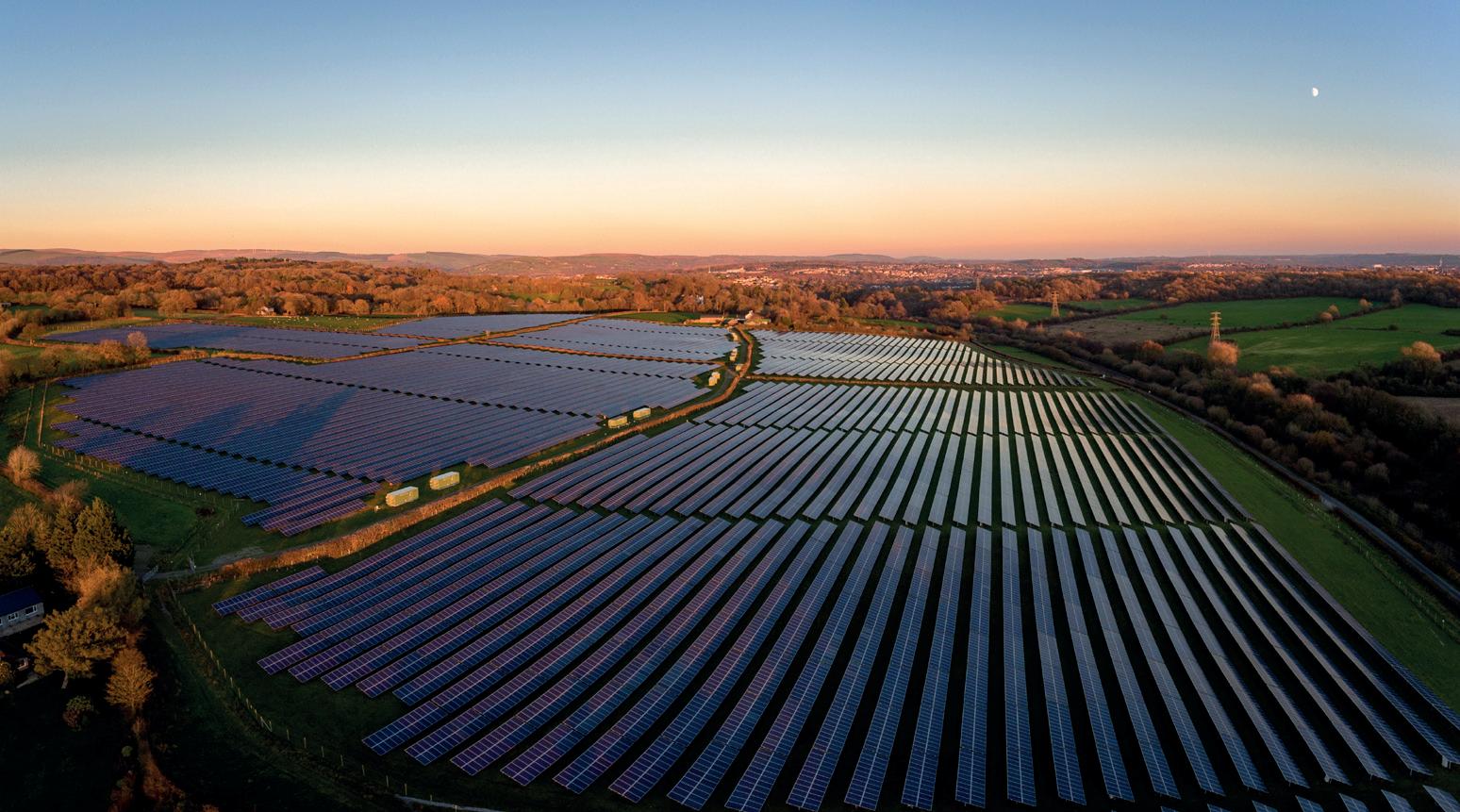

The application was submitted to the Planning Inspectorate for consideration by Longfield Solar Energy Farm Limited and following an examination during which the public, statutory consultees and interested parties were given the opportunity to give evidence to the examining authority, recommendations were made to the Secretary of State who has not accepted their recommendations..
Energy Security Secretary Grant Shapps said: “The UK already has enough solar power installed to power four million homes, and this new development of Longfield, the UK’s largest capacity consented solar farm, will help ensure we fully harness the power of the sun and boost our energy security.
“With a capacity to power tens of thousands of homes, Longfield will help deliver cheaper energy for consumers and businesses and create long-term, high-quality jobs of the future.”
YORKSHIRE WATER secures renewable energy deal with SHELL ENERGY
The water supplier has secured a ten-year deal with Shell Energy to purchase renewable energy from the Thanet and Dogger Bank offshore wind farms.
Yorkshire Water has entered a ten-year power purchase agreement with Shell Energy, aiming to buy renewable energy generated by the Thanet and Dogger Bank offshore wind farms.
Thanet, located off the coast of Kent, has an operational capacity of 300MW with 100 wind turbines, while Dogger Bank, off the north-east coast of England, is set to be one of the world’s largest wind farms, reaching an installed capacity of 3,6GW when fully operational.
Starting from October 2023, Shell Energy Europe, with agreements in place for both Dogger Bank and Thanet, will supply Yorkshire Water with approximately 16% of its electricity needs.

Currently, around 18% of Yorkshire Water’s power is already generated from renewable sources such as sludge.
Dan Oxley, Yorkshire Water’s Commercial Programme Manager, stated that their goal is to reduce energy consumption and procure more renewable energy in line with their net zero emissions target.
Oxley explained that with energy being one of Yorkshire Water’s major operational costs, the tenyear agreement with Shell Energy will help mitigate volatility in the energy market and potentially lower costs, benefiting the people of Yorkshire.
39 NEWS
PARLIAMENT questions credibility of UK clean energy plans
The UK Parliament’s Public Accounts Committee (PAC) has said it
that
government’s plans for expanding solar, wind and nuclear power are credible.
The UK Parliament’s Public Accounts Committee (PAC) has said it is sceptical that the government’s plans for expanding solar, wind and nuclear power are credible.

In a new report, the committee said that the UK’s current operating capacity is a quarter of the goals set for nuclear, solar and offshore wind power, with expansion plans relying in part on technology still at an early stage.
The government estimates that up to £400bn of public and private investment in new generating capacity will be needed by 2037, but the PAC said it is unconvinced that the private sector has been given enough clarity to confidently invest.

The committee, which monitors public spending, is now calling on policymakers to provide annual progress updates to Parliament and pull together numerous decarbonisation plans into a “coherent strategy”.
It said the nation’s green power goals would be jeopardised by lack of an overarching government plan.
This should be pulled together by autumn 2023 at the latest, the report recommends.
The government’s delivery plan must also set out when and how the costs of decarbonising the power sector will be likely to have an impact on energy bills and taxpayers.
The costs to build, maintain and operate the power system are typically passed onto consumer bills, but the government has not yet assessed what the costs of the clean energy transition ultimately mean for the general public, the committee suggested. It added plans to improve energy efficiency and change consumer behaviour, both key to meeting net zero, are not clear.
NEWS 40
is sceptical
the
GOVERNMENT support unlocks £300k for ACEON’S energy transition ambitions

UK Export Finance (UKEF) has announced £300k of support for Telford-based battery manufacturer AceOn, allowing it to secure new export contracts in the Portuguese renewable energy market.
This deal sees UKEF use its partnership with non-bank lender Newable to support the export ambitions of small and medium-sized enterprises through its General Export Facility scheme. This scheme has unlocked almost £250 million of working capital for UK exporters since it was first launched in March 2021.
UKEF’s support has allowed AceOn to win new contracts to supply batteries to Portuguese firm Meterboost, a manufacturer of solar energy and energy storage technology established in 2019.
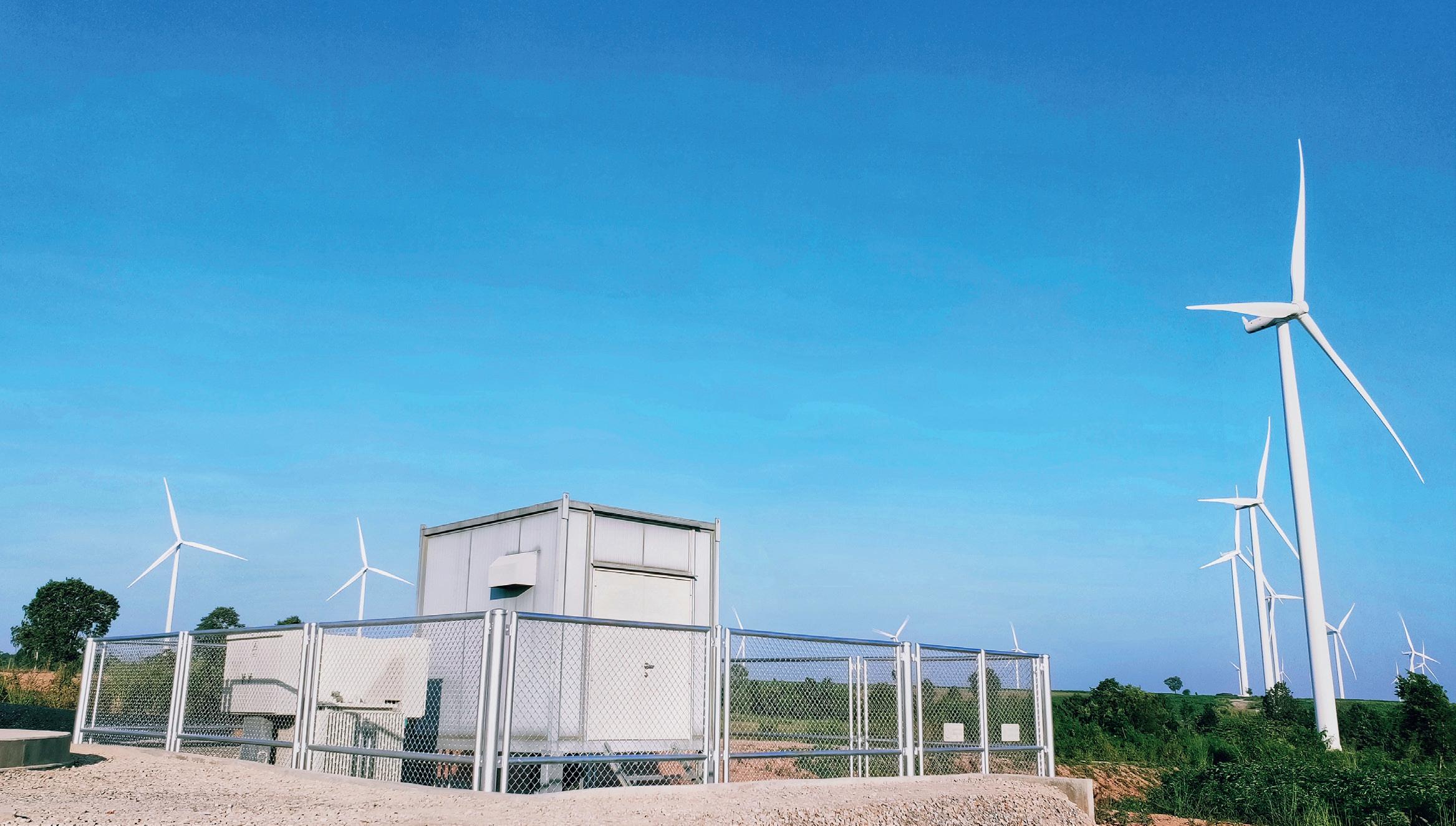
Tim Reid, CEO of UK Export Finance, said: “Flexible trade finance products like the General Export Facility mean that we have more to offer SMEs than ever. AceOn is a great example of a small
company with extraordinary ideas, and I am proud to help them seize opportunities for driving the global energy transition.”
The announcement comes as AceOn uses the Lisbon Energy Summit to announce its latest collaboration with Meterboost, which will see AceOn supply batteries for the Portuguese firm’s off-grid battery energy storage systems (BESS) for residential and commercial use.
Mark Thompson, Managing Director of AceOn, said: “Newable’s support has allowed us to finance the huge number of cells needed for our export of battery energy storage systems to Meterboost. Alongside this, UKEF’s backing has been key to driving our exports – together, they
have brought us from our first contracts with Meterboost to our latest collaboration with them, which I am proud to announce at the Lisbon Energy Summit.”
Philip Reynolds, Managing Director of Lending, Newable, said: “It is great to have been able to support an exporting, high-growth SME with a Newable Export Finance loan. We are grateful for the continued support of the UKEF GEF scheme, which has enabled this business to secure new export opportunities, create jobs and continue to grow.”
This latest deal adds to more than £7 billion in support that UKEF has already dedicated to the UK’s renewable energy sector since 2019.
41 NEWS
How can businesses tackle their energy costs whilst remaining competitive?

Morten Wierod, President of ABB Electrification, explores the additional pressure that soaring energy costs are putting on businesses worldwide.
Energy costs have been at the forefront of the global news agenda during the past year. While much has been written about the ‘cost-of-living’ crisis for consumers and society, less has been highlighted about the ‘cost-of-operating’ businesses are facing, caused by global uncertainty, including the potential knock-on effects on profitability and growth and investment in the workforce.
ABB’s recently commissioned Energy Insights Survey of business leaders globally found that energy cost and stability challenges are impacting businesses across the board, with 92% of survey respondents indicating rising costs are threatening their company’s competitiveness.
Much of the impact stems from tough decisions companies are reluctantly having to make about their cost and investment allocations. Respondents made it clear that dealing with energy challenges will override spending plans that would normally enable their organization to develop talent or invest in new technology capabilities for greater productivity, agility and speed.
But how can businesses maintain their competitiveness whilst addressing fluctuating energy costs and the challenges that come with it?
Pressure on workers and businesses
With more than 9 out of 10 businesses stating that energy costs are impacting their profitability, this has resulted in reduced investment in the workforce in the last year. If energy challenges persist, this trend is expected to continue over the
next three to five years, with three of the top five business areas highlighted for budget reductions related to the workforce: 42% say they will spend less on recruitment; 38% will decrease spending on salaries, overtime, and bonuses; and 37% will reduce investment in staff training and development.
Industry 4.0
With Industry 4.0 and the increasing digitalization of many businesses, it is vital that organizations can invest in their own development of products and services, as well as the back-end data and software to enable their delivery. The potential cutting or reallocation of this investment may have negative effects on a business, yet 38% of respondents said that they had reduced spend on technology, 33% on infrastructure and 18% on R&D investment in the past year.
The global digital transformation market size per revenue surpassed $594bn in 2022 and is expected to have a continued annual growth of more than 20% to hit nearly $1,550bn by the end of 2027. Competitors who continue their R&D efforts will inevitably have the upper hand when it comes to bringing products to market. By diverting investment elsewhere to survive, the reality is that businesses may lose out to their competition. Many manufacturers, for example, are rethinking their production lines to automate processes, requiring investment and new skills to implement these. Organizations are shifting from on-premises

data centres to cloud-based services and increasing leaning on edge computing to support that shift; all of which takes time and money and requires not only investment in technology but also a digital skillset of specialists who can help businesses to embrace the digital opportunity.
Sacrificing sustainability
The report shows that more than 58% of business leaders said the cost of energy could delay achieving their sustainability and carbon reduction targets by anywhere between one and five years. Reducing energy costs is now ranked as the top priority for 61% of companies. Overall, these concerns about energy prices and the action businesses are taking to reroute investment to pay rising energy bills could delay progress on climate change globally, with businesses focusing less on decarbonization and prioritizing reducing their energy costs instead.
We need to move more quickly on both the supply and demand sides of the equation by harnessing technology tools and new ways of working to optimize energy across the value chain. Supporting businesses in the take-up of proven technologies in energy management, efficiency, as well as renewable energy generation and storage will help to insulate them from the impacts of fluctuating energy costs and security concerns.
The good news is that, with the right approach, businesses don’t have to trade off climate and growth goals. Reduced energy costs and increased energy reliability should alleviate cost pressures and enable investment in key areas of people, business growth, and sustainability to be maintained. This should help to attract the next generation of digitally skilled people that are so vital to drive the energy transition forward.
OPINION 42
IS IT CHEAPER TO COOK WITH AN AIR FRYER, OVEN MICROWAVE OR SLOW COOKER?
Energy bills are still high, so it makes perfect sense to keep finding new ways to reduce how much gas and electricity you use in each room of your home. Did you know that some appliances are more efficient when it comes to preparing different types of food? Or that you can save by simply swapping to a different appliance for certain tasks?
To help you save energy and money in your kitchen, our energy experts have looked at how much it costs to use some common cooking appliances. Keep reading to find out which appliances to use the next time you’re rustling up a recipe.
ELECTRIC OVENS
BEST FOR BATCH COOKING
TYPICAL COST PER USE: £0.27
Ovens are generally bigger than other cooking appliances, so they need to use more energy to heat up. This means a typical electric oven can be the most expensive cooking appliance to run. However, their larger size means you can fit a lot of food in at once, so they’re better for batch cooking or cooking for a large group. Using your oven in these situations could be the best value for money.
TOP TIP: Try not to open the compartment any more than necessary to avoid letting out heat and wasting energy.
GAS OR ELECTRIC HOB MICROWAVE
BEST FOR QUICK MEALS
TYPICAL COST PER USE: £0.01 - £0.02
Using the hob is typically quite cheap because, generally, you won’t need to have a hob on for very long to prepare meals such as pasta or an omelette. Using a gas hob does produce more direct carbon emissions than an electric hob, so if you’re just using it to reheat food, you might want to think about using a microwave instead to reduce your carbon footprint.
TOP TIP:
Remember to cover your pots and pans with a lid when you’re cooking to keep heat in and reduce wasted energy.
AIR FRYER
BEST FOR ONE TO TWO PEOPLE
TYPICAL COST PER USE: £0.07
An air fryer works like a small conventional fan oven. Because it’s small, using an air fryer can often be cheaper than using your oven for the same meal. This makes it ideal for preparing smaller amounts of food for one or two people.
TOP TIP:
Try not to open the compartment any more than necessary to avoid letting out heat and wasting energy.
BEST FOR REHEATING AND QUICK COOKING
TYPICAL COST PER USE: £0.04
Instead of heating the air around it, your microwave directly heats the food. This means your microwave will cook and reheat food very quickly, so its cost per use is likely to be lower than many other cooking appliances.
TOP TIP:
If you’re preparing a large meal, batch cooking in a full oven and then reheating portions as you need them in the microwave can be a good way to keep your energy bills down.
SLOW COOKER
BEST FOR BUSY SCHEDULES
TYPICAL COST PER USE: £0.26
These are designed to cook food gradually over a long period of time. Slow cookers can be a convenient way to cook if you have a busy schedule.
TOP TIP:
To save energy, try to avoid leaving them on longer than necessary, and use the ‘low’ setting if you’re going to be out for longer.
HARNESSING SOLAR ENERGY The Ultimate Guide to in the UK

In recent years, the UK has been increasingly embracing renewable energy sources and despite the common misconception that the UK’s often cloudy skies are a hindrance to solar energy, the truth is far from it.
Understanding Solar Energy
Solar energy is a clean, renewable source of power that harnesses the sun’s rays to produce electricity or heat. Solar panels, often mounted on rooftops, capture and convert sunlight into usable energy. Despite the initial costs, solar energy is a long-term investment that not only reduces your carbon footprint but can also significantly cut down your utility bills.
How Solar Panels Function
Solar panels work by utilising photovoltaic (PV) cells to convert sunlight into direct current (DC) electricity. An inverter then transforms this DC power into alternating current (AC) electricity, which can be used to run household appliances or sent back to the grid.

Solar panels don’t need direct sunlight to function. Even on a cloudy day, they can produce around 10-25% of their full capacity. Therefore, while the UK may not be famous for its sunny weather, solar panels can still be an effective option for generating renewable energy.
Types of Solar Panels
There are primarily three types of solar panels, each with their own set of advantages and disadvantages.
MONOCRYSTALLINE SOLAR PANELS
Monocrystalline panels, identified by their sleek, black appearance, are made from a single crystal structure. They offer the highest efficiency rates (15-20%) among all panel types due to the high purity of silicon used in their production. However, they also come with a higher price tag.
POLYCRYSTALLINE SOLAR PANELS
Polycrystalline panels are created by melting multiple silicon fragments together. They are less efficient than monocrystalline panels, with efficiency rates ranging between 13-16%. However, they are more affordable and produce less waste during manufacturing.
THIN-FILM SOLAR PANELS
Thin-film panels are the cheapest option on the market. They are easy to produce and can even be made flexible, opening up new application possibilities. However, they are less efficient and require more space compared to the other two types.
Benefits of Solar Panels
Opting for solar energy comes with a host of benefits, both for the environment and your wallet.
ENVIRONMENTALLY FRIENDLY
Solar energy is a renewable resource, meaning it won’t run out as fossil fuels might. By switching to solar power, you can significantly reduce your carbon footprint and contribute to the fight against climate change.
ENERGY INDEPENDENCE
With solar panels, you can generate your own electricity and become less dependent on the grid. This can prove beneficial, especially during energy price hikes or power cuts.
LONG LIFESPAN
Solar panels are built to last. Most panels come with a warranty of 25 years, but they can often continue to produce electricity even beyond that.
GUIDE 44
1
2 3
Drawbacks of Solar Panels
While solar panels come with numerous benefits, there are also a few drawbacks to consider.
HIGH UPFRONT COST
The initial expense of purchasing and installing solar panels can be quite high. However, the long-term savings on your energy bills can help offset this cost over time.
WEATHER DEPENDENT
While solar panels can produce electricity even on cloudy days, their efficiency is significantly higher during bright, sunny days. Therefore, their performance can fluctuate with the weather.
REQUIRES SPACE

Solar panels require a considerable amount of space for installation, typically on your roof. The number of panels you can install, and consequently the amount of energy you can generate, will depend on the available space.
Cost of Solar Panels in the UK
The cost of solar panels can vary greatly depending on the type, size, and installation complexity. On average, a typical 4kWp solar PV system in the UK can cost between £5,000 and £8,000. If the panels are integrated into the roof, the cost can go up to £10,000 to £15,000. For solar thermal systems, the price range is roughly similar, between £5,000 and £8,000 It’s important to note that while the upfront cost may seem high, the long-term savings through reduced energy bills and potential earnings from selling excess electricity back to the grid can make solar panels a worthwhile investment.
Solar Panel Maintenance
Contrary to what you might think, solar panels require very little maintenance. In the UK, panels that are tilted at 15° or more are usually cleaned by rainfall. However, you may need to occasionally clean the panels if they become covered in dust or debris.
Most solar panels come with a 25-year warranty, but keep in mind that the inverter, the device that converts the DC electricity generated by the panels into AC power, will typically need to be replaced after 10 to 15 years.

Solar Panel Installation
Installing solar panels involves mounting them on your roof and connecting them to an inverter. If you’re considering installing solar panels, it’s crucial to ensure your roof is structurally sound and able to support the weight of the panels.
It’s also important to consider the orientation and tilt of your panels for maximum sunlight exposure. In the UK, panels should ideally face south at an angle of around 35°. Shading can significantly impact the efficiency of solar panels, so ensure there are no obstructions like trees or buildings that could block sunlight.
Planning Permission for Solar Panels
In most cases, installing solar panels falls under the permitted development rights and does not require planning permission. However, there are some exceptions. For instance, if your property is listed or located in a conservation area, you may need to apply for permission. It’s always a good idea to check with your local planning authority before installing solar panels.
Government Grants for Solar Panels
While the Feed-in Tariff (FiT) scheme, which paid homeowners for the electricity they generated with their solar panels, ended in 2019, there are still ways to get financial support for solar energy.

The Smart Export Guarantee (SEG) scheme, introduced in 2020, requires energy suppliers to pay homeowners for the surplus electricity they export back to the grid. While the rates are generally lower than what was offered under the FiT scheme, it can still help offset the cost of solar panels.
In conclusion, while the initial cost of solar panels can be high, the long-term benefits make them a valuable investment for those looking to save on energy bills and reduce their environmental impact. With the UK government’s pledge to achieve net-zero carbon emissions by 2050, the future of solar energy in the UK looks promising.
45 GUIDE
ANALYSING THE RENEWABLE ENERGY LANDSCAPE: HOW DOES THE UK COMPARE WITH GLOBAL TRENDS The and not planet the economy
The United Kingdom has made significant strides in this area, setting ambitious targets and implementing strategic measures to transition from fossil fuels to greener alternatives. Here we delve into the state of renewable energy in the UK, comparing it with global trends and analyse the progress made thus far.

THE IMPORTANCE OF RENEWABLE ENERGY: ADDRESSING THE CLIMATE CRISIS
The effects of climate change are increasingly evident, and the need for immediate action is more urgent than ever. One of the most potent contributors to greenhouse gas emissions is the burning of fossil fuels for electricity. To mitigate this, the UK has set a target to achieve net-zero carbon emissions by 2050, with all electricity coming from 100% zero-carbon generation by 2035.
THE CURRENT STATE OF
RENEWABLE ENERGY IN THE UK
Renewable energy sources, which emit little to no carbon emissions, are a crucial component of this strategy. By harnessing the power of wind, solar, hydroelectric, and bioenergy, we can significantly reduce our carbon footprint and make strides towards a more sustainable future.
As of today, the UK relies on a mix of renewable sources for electricity generation, with wind power contributing the most substantial share. Despite the continued dominance of natural gas in the national grid, the proportion of renewable energy is growing.
In 2020, the UK marked a historic milestone by generating more than 43% of its power from renewable sources for the first time. This trend

continued into 2021, with individual renewable sources contributing significantly to the total electricity generation.
Specifically, wind power contributed 26.8%, biomass energy 5.2%, solar power 4.4%, and hydropower 1.8% to the renewable mix. These figures highlight the increasing reliance on renewable energy sources and the decreasing dependency on fossil fuels.
RENEWABLE ENERGY 46
47 RENEWABLE ENERGY
RECORD-BREAKING ACHIEVEMENTS IN THE UK’S RENEWABLE ENERGY SECTOR


The UK’s journey towards a more sustainable future has been marked by several record-breaking achievements. Among these are:
• The share of zero-carbon power in Britain’s electricity mix grew from less than 20% in 2010 to over 50% in 2022.
EVOLUTION OF RENEWABLE ENERGY USAGE IN THE UK
The use of renewable energy sources in the UK has seen a significant change over the past few decades. In 1991, renewables accounted for a mere 2% of all electrical generation. By 2013, this figure had risen to 14.6%.
The UK’s position as a leader in renewable energy generation in Europe was solidified in 2017. Only countries with more established renewable schemes, such as
Iceland, Norway, and Sweden, used more on a relative scale.
In 2019, a significant milestone was reached - zero-carbon electricity production overtook fossil fuels for the first time. This trend continued into 2022, with renewables outperforming traditional fossil fuel generation by providing 48.5% of the electricity used, compared to 40% from gas and coal power stations.
The UK achieved its lowest ever carbon intensity month in February 2022, matching the previous record set in April 2021.
• In 2020, renewables accounted for more than 43.1% of the UK’s total electricity generated, outstripping fossil fuels over the course of a year for the first time in the nation’s history.
• Also, in 2020, the UK had its longest run of coal-free power, with a total of 68 days between April and June.
DECARBONISATION: THE FUTURE OF ENERGY IN THE UK
The UK’s goal isn’t for renewables to be the sole provider of energy, but rather to be a significant part of a diverse, clean energy mix. Plans are already underway to dramatically increase the UK’s renewable capacity over the next decade.
Offshore wind output is expected to increase from 11GW to 50GW by 2030, aided by a £200 million government
investment and financial incentives. Similarly, solar capacity could grow five-fold in the same period.
Combined with other low-carbon electricity sources, such as nuclear energy, these plans indicate that the UK’s green infrastructure is heading in the right direction to meet the government’s 2035 target and ultimately achieve net-zero emissions.
shift towards a more sustainable renewable energy landscape is only necessary for the health of our planet but also plays a pivotal role in economy and public health sectors.
THE GLOBAL ENERGY MIX: A COMPARATIVE ANALYSIS

While the UK is making significant progress in its renewable energy efforts, it’s crucial to put this in a global context. The world’s energy mix varies significantly across countries, with fossil fuels still dominating overall. They account for more than 80% of global energy consumption.
THE ROAD AHEAD: THE FUTURE OF RENEWABLE ENERGY IN THE UK
However, countries with abundant hydropower resources, like Brazil, Canada, Sweden, or Norway, generate over two-thirds of their electricity from renewable sources. Some countries have also seen a surge in renewable energy generation due to ambitious renewable policies and the decreasing costs of solar and wind technologies.
GLOBAL TRENDS IN RENEWABLE ENERGY
Between 2020 and 2021, the global share of renewables in the power mix remained stable at 28.1%, up from 26.3% in 2019. Countries like Australia have seen a significant rise in the share of renewables in their power mix, demonstrating the global shift towards more sustainable energy sources.
However, the speed and scale of the energy transition needed today is different from the past. Historically, energy transitions have occurred slowly. The rapid switch from fossil fuels to low-carbon energy sources that we need today presents a new and unique challenge.
THE ROLE OF GOVERNMENT AND POLICY IN RENEWABLE ENERGY PROGRESS
Government policies and actions play a crucial role in shaping a country’s renewable energy landscape. The UK government’s introduction of the Renewable Obligation (RO) policy in 2002, for example, has been instrumental in reducing carbon emissions.

Furthermore, the Feed-in-Tariffs (FiT) scheme introduced in 2010 resulted in a net increase of 6134.7 MW of capacity in the UK by 2017. This accounted for 20% of the total installed renewable capacity.
CHALLENGES AND OPPORTUNITIES IN RENEWABLE ENERGY TRANSITION
While the transition towards renewable energy presents numerous opportunities for environmental sustainability and economic growth, it isn’t without its challenges. These include technological constraints, economic
factors, and policy and regulatory barriers.
However, with strategic planning, investment in research and development, and the continued support of government policies, these challenges can be overcome.
The UK is on an encouraging trajectory towards a more sustainable future. The continued growth of renewable energy, coupled with ambitious targets and strategic government policies, suggests a promising outlook. While the journey towards a fully renewable energy landscape is complex and challenging, the progress made thus far is a testament to what is achievable.
The UK’s experience serves as an inspiration for other countries on their path towards sustainable energy.
As we move forward, it is essential to continue investing in renewable energy technologies, promote policies that encourage sustainability, and foster a culture that values and prioritises the health of our planet.
RENEWABLE ENERGY 48
Harnessing the Power of Summer: Top Tips for Maximising Renewable Energy Usage
Summer brings longer days and shorter nights, making it an excellent time to harness the power of renewable energy. With the right strategies, you can maximise your renewable energy usage and reduce your carbon footprint.
The Power of the Sun
The sun is a powerful source of energy. In just one hour, the sun provides the earth with more energy than the entire world uses in one year. This energy is clean, renewable, and abundant, especially during the summer months.
Solar Energy Systems
Solar energy systems convert sunlight into electricity. There are two main types of systems – photovoltaic (PV) systems and solar thermal systems.
Photovoltaic Systems
Convert sunlight directly into electricity using solar cells.
Solar Thermal Systems
On the other hand, capture the sun’s heat and use it to heat water or air for use in homes and businesses.

Maximising Solar Energy
There are several steps you can take to maximise your solar energy usage:
1. Install solar panels on your roof.
2. Ensure your solar panels are clean and unobstructed.
3. Use solar energy during peak production hours.
4. Invest in a solar battery to store excess energy.
Wind Power
Wind power is another form of renewable energy. While wind patterns can be unpredictable, summer months often bring consistent winds, making it an ideal time to harness wind power.
Hydropower
Hydropower is a form of renewable energy that uses the movement of water to generate electricity. Summer rains can increase hydropower generation, especially in areas with large rivers or reservoirs.
Battery Storage
Battery storage is essential for maximising renewable energy usage. By storing excess energy, you can use it when your renewable energy systems are not producing energy, like at night or during periods of low sunlight or wind.
Energy Efficiency
Maximising renewable energy usage is not just about generating more energy – it’s also about using energy more efficiently. Energy-efficient appliances, insulation, and energy-saving habits can all help you get the most out of your renewable energy systems.

Government Initiatives
Many governments offer incentives to encourage renewable energy usage. These may include grants, tax breaks, and feed-in tariffs. It’s worth researching what’s available in your area.
Conclusion
Maximising renewable energy usage during the summer months can help reduce our reliance on fossil fuels, lower our energy bills, and contribute to a healthier planet. So why not harness the power of summer and go green?
49 CARBON OFFSETS
Solar power is the last energy resource that isn’t owned yet. Nobody taxes the sun yet. ” “
Bonnie Raitt
INVESTING IN A HOME BATTERY: A GREENANDECONOMIC POWER
Gone are the days when the concept of home energy storage was considered a novelty. As the is shifting towards renewable energy, the potential of home batteries is becoming more evident. understand the benefits of investing in a home battery for a more sustainable and economical

A GLIMPSE INTO HOME ENERGY STORAGE
Home energy storage, often referred to as solar or home batteries, is a technology that allows you to store electricity for later use. This technology is particularly effective for those who generate their own power through solar panels but need to utilise it beyond daylight hours.
One of the significant advantages of home batteries is their compatibility with the concept of a ‘smart home’. Many advanced storage systems enable you to track your energy usage online and charge the batteries with low-rate electricity from the grid during off-peak hours.
THE CASE FOR SOLAR BATTERY STORAGE
If you already have solar PV panels installed or are planning to, then using home batteries to store the electricity you’ve generated can help you maximise the amount of renewable energy you use. In fact, according to a survey, 60% of people who have, or would consider, a home battery stated that they want to use more of the electricity generated by their solar panels.
Additionally, home-energy storage can reduce your grid electricity usage and thus cut your energy bills. If your home is off-grid, it can help reduce your reliance on fossil fuel back-up generators.
However, the initial cost of home-energy storage is quite substantial, often upwards of £2,000. Therefore, it’s crucial to evaluate whether the investment would be worthwhile and how soon you can recoup your investment through savings on your energy bills.
SIZE MATTERS: CHOOSING THE RIGHT SOLAR STORAGE BATTERY
When it comes to selecting a solar storage battery, the size is a crucial factor. The average home uses around 8kWh of electricity per day, while the capacity of new lithium-ion batteries ranges from around 1kWh up to 15kWh.
You would ideally want a battery that can cover your evening and night-time electricity usage and can be fully recharged in daylight. Moreover, it’s important to consider the power generation capacity of your solar panels, as there’s no point in buying a battery that’s larger than what your panels can fill.
THE MONETARY ASPECT OF SOLAR BATTERIES
When considering whether a solar battery can save you money, a few factors come into play. These include the installation cost, the type of system installed (DC or AC), its usage, the price of electricity, and the battery’s lifespan.
Several battery systems offer a warranty of 10 years. They require minimal maintenance, with the main cost being the initial installation. However, considering solar PV panels can last 25 years or more, you should factor in the cost of replacing the battery at least once during this period.
While batteries are expensive to buy, prices are continuously dropping. Hence, with electricity prices at record highs, the payback times for solar batteries are improving.
FINANCING YOUR ENERGY STORAGE
While the prices of batteries are gradually decreasing, it still represents a substantial investment. The best option is to pay for your battery upfront using your savings. Alternatively, you could consider a loan, but remember to factor in the interest cost.

ADVICE 50
BATTERY: POWER SOLUTION
the paradigm of power generation evident. This article will help you economical energy solution.
Make sure that the savings made from the battery storage would outweigh this additional expense.
In Scotland, the government offers interest-free loans to homeowners to fund energy-saving improvements,
including energy storage. Borrowers can receive up to £15,000, which must be repaid within 10 years.
THE PROMISE OF BIG-NAME BRANDS
Several renowned tech brands, including Samsung and Tesla, as well as energy companies like EDF Energy, Eon, and Ovo, have entered the home-energy storage market. These companies are offering solar panel and storage packages, making it more convenient for consumers to opt for cleaner, renewable energy.
MAKING AN INFORMED DECISION: BATTERY STORAGE PRODUCTS AND PRICES
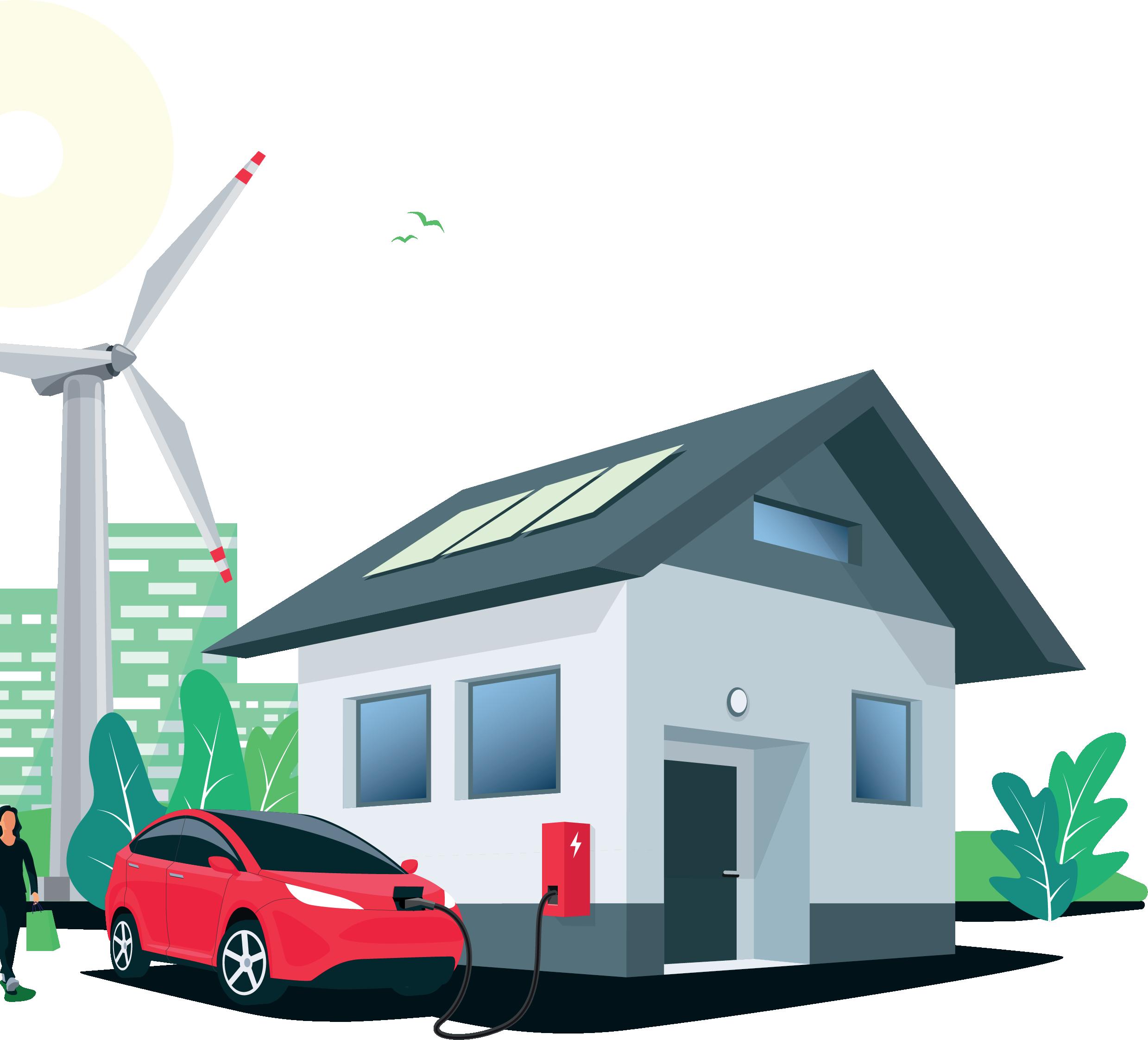
To make an informed decision about investing in home-energy storage, it’s essential to compare various products in terms of their prices, capacities, and key features. Keep in mind that the usable capacity is usually less than the stated capacity due to energy loss during charging and discharging.

BEFORE INSTALLING A HOME-ENERGY STORAGE SYSTEM
Before you decide to install a home-energy storage system, it’s crucial to evaluate whether you’re generating enough electricity to justify the investment in energy storage. If you’re looking to protect yourself against power cuts with a home battery, remember that not all systems are suitable.
PROS AND CONS OF SOLAR PANEL BATTERY STORAGE
Like any investment, home batteries come with their set of pros and cons. On the one hand, they can help you use more of the electricity you generate and potentially save you money. On the other hand, they are currently quite expensive, and their payback time may be lengthy. Hence, it’s crucial to weigh all aspects before making a decision.
Investing in a home battery can be a gamechanger for your home energy management. It not only allows you to make the most of your solargenerated energy but also contributes to a more sustainable and green energy future. Even though the initial investment might be high, the long-term benefits and savings make it a worthwhile endeavour for many homeowners.
51 ADVICE




COMING IN SEPTEMBER & Powered by




























































































































